Tagged with 'Pearl fashion'


The very latest news, musings and opinions from the world of Winterson. Quite simply, a celebration of a jewellery, fashion, culture and the business behind luxury.
-
Winterson Prize 2019: Meet the Designers
Winterson Prize 2019: Meet the Designers
Each year we work with the student jewellery designers at Central Saint Martins in London, giving them an opportunity to experience designing with pearls for their final year collections.
We will be awarding the Winterson Prize 2019 to one of the students for ‘The Best Use of Pearls’ at the CSM Jewellery Awards Evening on 20th June. The BA Jewellery graduate collections are exhibited at CSM and open to the public from June 19th - 22nd.
Here we feature the first part in a series of short interviews with designers from the CSM Jewellery 2019 show, including in this article - Ayse Daga, Diana Jung, Fermin Cheung, Hao-Yang Lai, Juntao Asa Ouyang and Wen-Ju Tseng.
Read about Juntao Asa Ouyang, the winner of this year's prize.
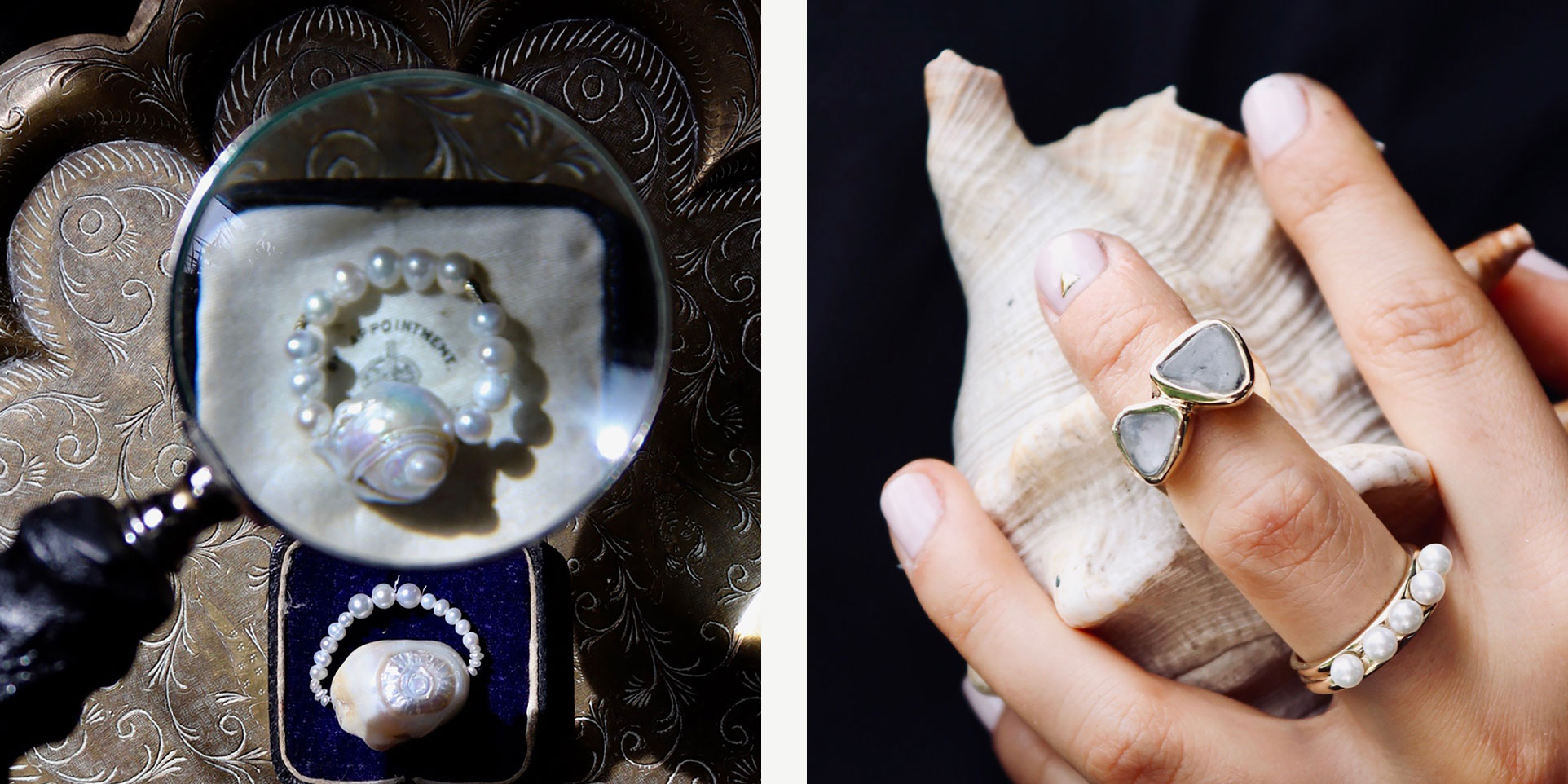
Ayse Daga
Tell us a little bit about yourself.
I have been passionate about creating since I was very young. Starting off with drawing and painting, I realised that I am interested in creating three dimensional forms that can either be personal or that communicates ideas in a broader sense. My main inspiration is history and admiration of different cultures around the world. Based in Istanbul, Turkey, I believe my interest for different cultures and history come from the rich historical past, traditions and crafts of my home country.
What was the inspiration for your Faces from Curiosities collection?
From broad to narrower sense, it was, history, culture, memories and human conscious. Cabinet of curiosities and Sigmund Freud’s collection of objects were two main inspirations for me to build up a starting point for my collection.
What do you find inspiring about pearls?
Definitely their roots and history. They are considered as the worlds’ oldest gems and were used for different purposes in different cultures. I am also very interested in their nature. Unlike gemstones that are mined from the earth, a living organism produces a pearl.
What have you discovered about working with pearls?
They are easier to carve compared to other stones. I also realized the interesting nature of the Baroque pearls. Their natural and irregular shapes are very inspirational.
Which designer or artist do you most admire?
Shinji Nakaba and Sevan Bıçakçı (he doesn’t use pearls a lot).
Who could you imagine wearing your jewellery?
To be honest anyone could wear my jewellery who appreciates the idea of history and culture. I always admire ancient tribal jewellery and consider myself as a maker and designer who reinterpret the idea of authenticity.
What’s next for you after CSM?
I’m planning to develop myself in terms of carving and engraving and hopefully expand my work to create my own business.
View more of Ayse's work here.
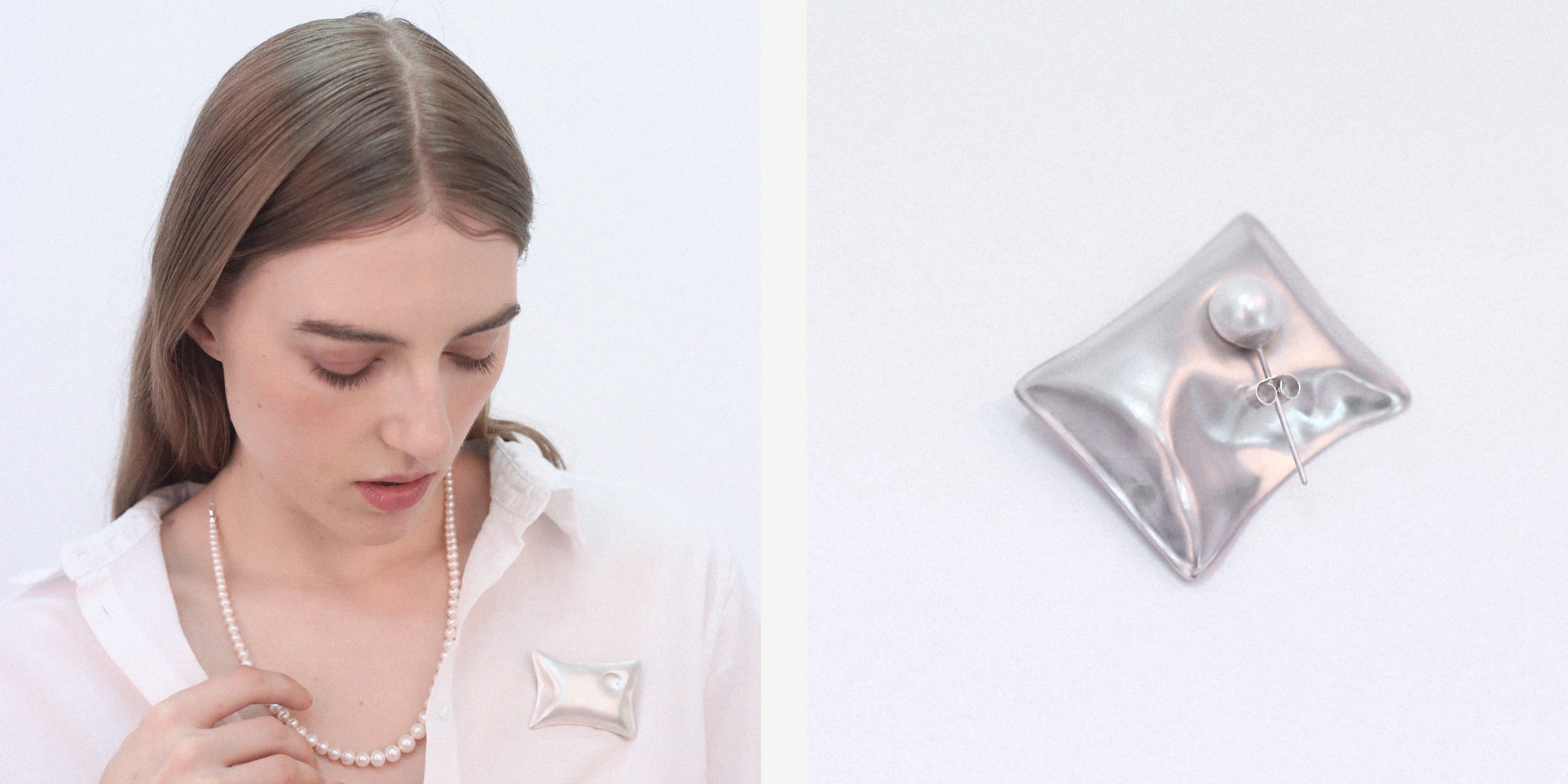
Diana Jung
Tell us a little bit about yourself.
My jewellery designs result in numerous attempts of embodying my delicate sensations into objects. I like designing sculptural pieces that are beautiful when they are both worn and not worn, which holds the features of both art jewellery and fine jewellery.
What was the inspiration for your Sense of Belonging collection?
Exploring the scenes of laundry, the subtle image of soft pillows hanging on the laundry lines left a strong impression on me. Pillows itself are such a symbolic object of home and a personal possession that remains nearest to the skin. Having something that exists in one’s private space and moments set out to the public, came upon as an unusual but also beautiful sight for me. Therefore, I decided to create a collection of puffy pillows which contains the nostalgia of one’s comfort place to be worn on the body for people to see.
What do you find inspiring about pearls?
I love the white soft texture of pearls. I find pearls fascinating in that they have such a calming, comforting look to them. I also think that pearls are special because they become heirlooms that can be cherished for a long time.
What have you discovered about working with pearls?
I found that pearls could be carved and transformed into various shapes. However, I eventually came to realize that pearls are the most beautiful when it is in its pure state.
Which designer or artist do you most admire?
Sculptor and installation artist Do Ho Suh, Rachael Whiteread, and fashion designer Pheobe Philo.
Who could you imagine wearing your jewellery?
I imagine my jewellery being worn by anyone who can relate to my pieces and understands the sensitivity of them.
What’s next for you after CSM?
I really enjoy designing and making jewellery and would love to start working in other companies. Eventually, I would like to have my own brand.
View more of Diana's work here.
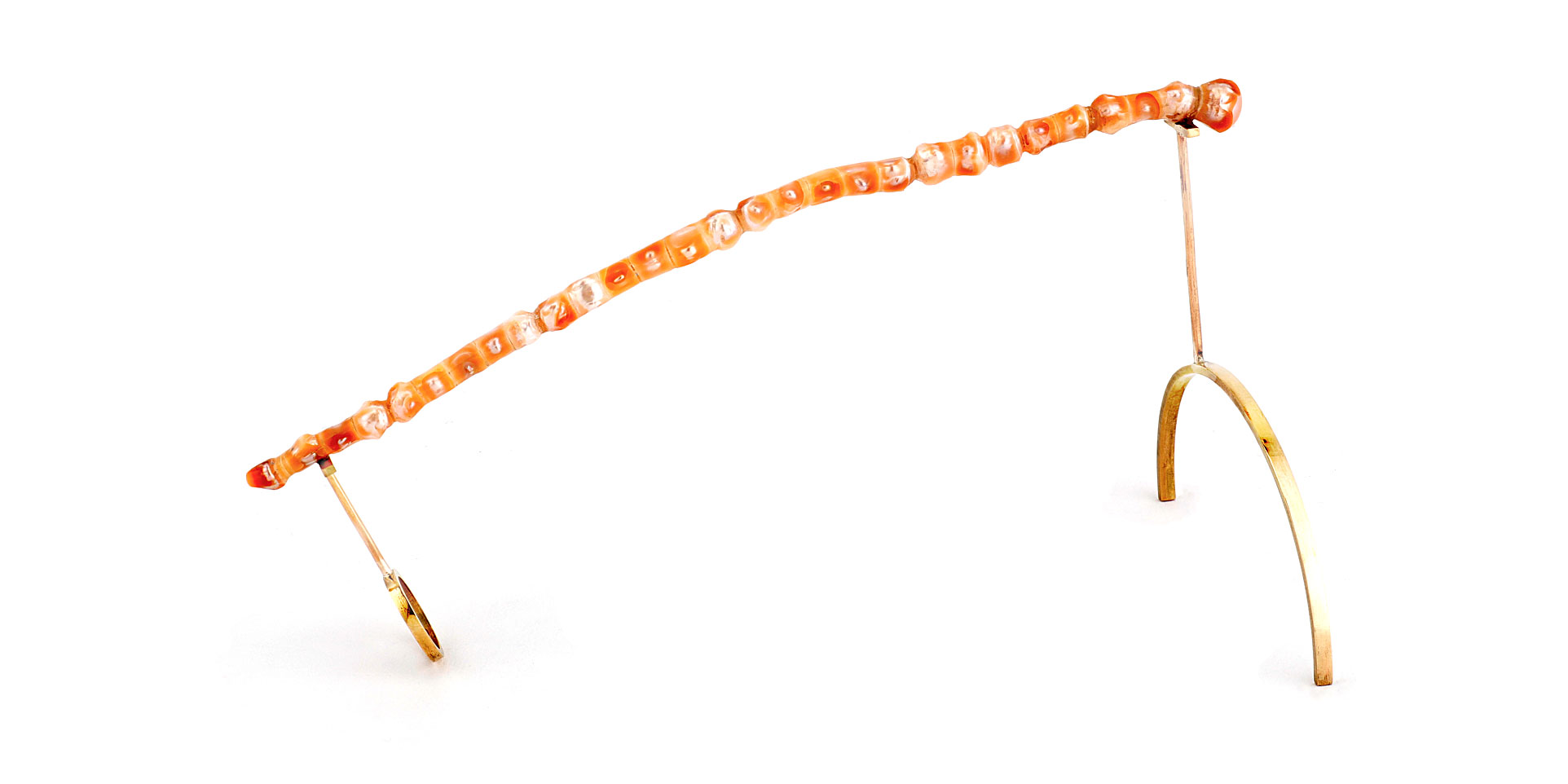
Fermin Cheung
Tell us a little bit about yourself.
Someone who likes drawing, painting and crafting but doesn’t understand contemporary arts.
What was the inspiration for your Vitana collection?
Shinji Nakaba who is a Japanese artist specialise in pearl carving; anatomy studies that I’ve been revising in my spare time and my essay which did some research on display methods in galleries.
What do you find inspiring about pearls?
The softness of the material is inspiring. Not just in its strength but also the visual that looks like layers of airbrush stacked on top of each other, creating a vibrant colour. The resin-like interior is also intriguing.
What have you discovered about working with pearls?
The properties of having layers in pearls which cause problems during carving; possibility of sculpting as the material is capable to provide contrast between hard edges and soft edges.
Which designer or artist do you most admire?
Shinji Nakaba; Neil Linnsen, Jiro Jur, Wlop and Shal_E.
Who could you imagine wearing your jewellery?
Audience that not only appreciate the visuals of a piece, but also appreciate the intentions or messages behind.
What’s next for you after CSM?
Utilising the degree and work for income, whether it is contemporary or commercial jewellery or any other aspects, supporting the study in illustration and concept art, potentially animation if time allows.

Hao-Yang Lai
Tell us a little bit about yourself.
I’ve always been interested in designing and making since I was young. As I begin my further studies at Central Saint Martins, I was very lucky to be in a position to truly explore myself. To me, jewellery is about challenging conventions and breaking boundaries. In the future, I intend to continue pushing my designs further and bring awareness to the social issues that I care deeply.
What was the inspiration for your Anthropocene collection?
The starting point of this collection was inspired by science fiction and the cyberpunk movement. As I developed my concept, I begin to realise how science fiction reflects our society and how it can inform my work. With science fiction movies like Blade Runner 2049 (2017), I was heavily inspired by imageries of the postmodern, apocalyptic world. My collection found itself inheriting many characteristics such as the cybernetic forms and clean design aesthetics from the film.
What do you find inspiring about pearls?
I think what’s most interesting about pearl is that they are natural forms. With my collection, I investigated with the relationship between man-made verses nature. The contrast between pearls and the artificial stone gives a new dimension to my collection.
What have you discovered about working with pearls?
I’ve discovered pearls have interesting qualities, such as the different reflections and colours, it's soft on the outside and hard in its core.
Which designer or artist do you most admire?
Anish Kapoor, Stanley Kubrick, Richard Serra
Who could you imagine wearing your jewellery?
Artists, collectors, designers.
What’s next for you after CSM?
I’m probably moving to Africa or South America to do volunteer work.
View more of Hao-Yang's work here.
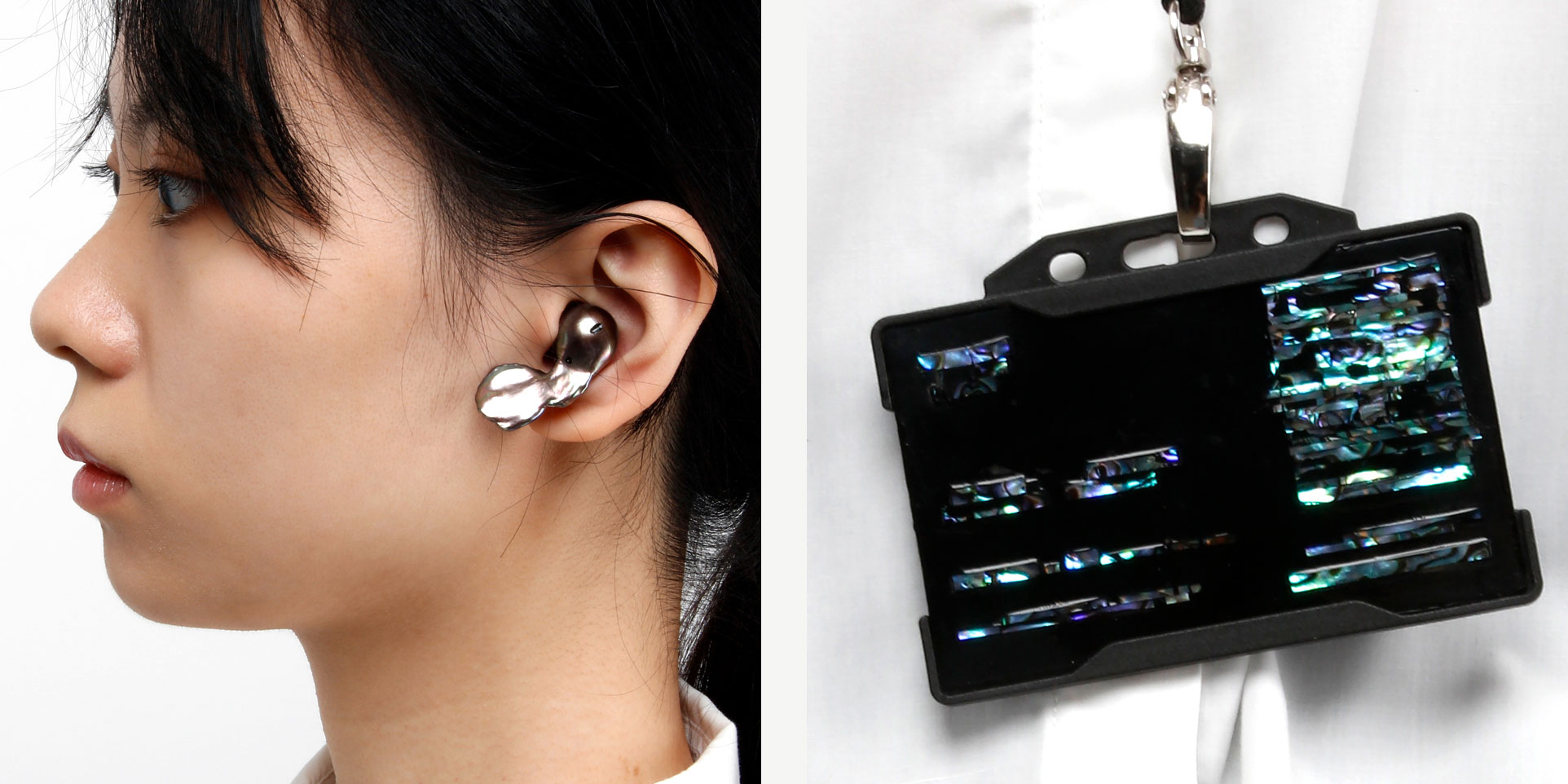
Juntao Asa Ouyang
Tell us a little bit about yourself.
I am a passionate designer who works with traditional craft skill and wants to interpret craft skills, craftsmanship in contemporary jewellery.
What was the inspiration for your Glitch collection?
My inspiration comes from the circumstances of people over-reliance on technology products. What would happen if all the technology that people depend on just shuts down? I aim to demonstrate the fear of how daily used technology may ‘Incorporate’ people if people rely too much on technology.
What do you find inspiring about pearls?
The uniqueness and colors of pearls is pretty inspiring.
What have you discovered about working with pearls?
I used mother of pearl and pearls in my collection. Colors of abalone shell can represent glitch screens in an abstract way. Natural baroque pearls come with different sizes and shapes. Seeking the right pearls for my collection is an interesting journey.
Which designer or artist do you most admire?
Theo Jansen and Gijs Bakker.
Who could you imagine wearing your jewellery?
People who like to warn themselves from over-reliance on technology products.
What’s next for you after CSM?
I would like to find a job in which I can learn while working.
View more of Juntao's work here.
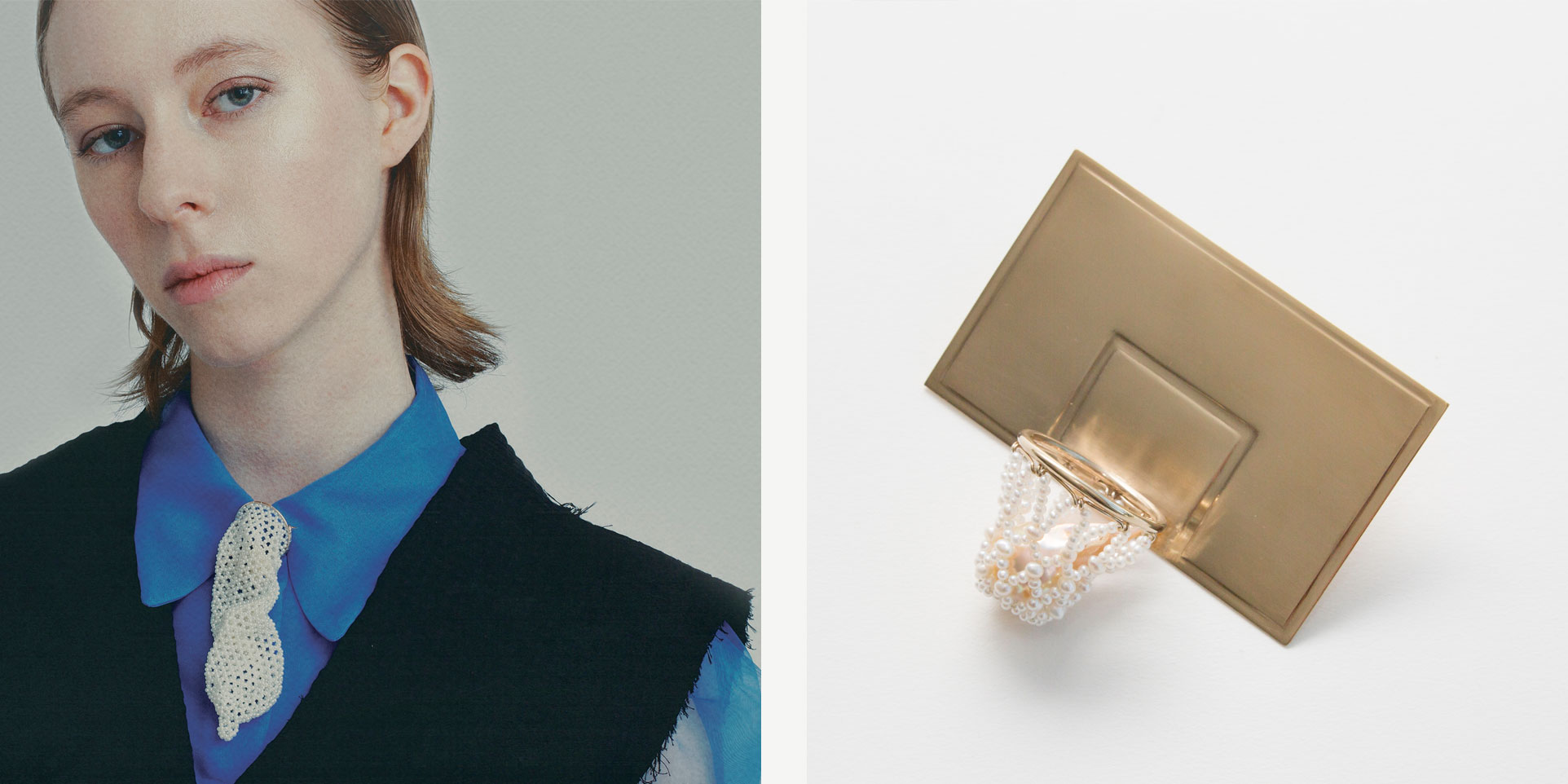
Wen-Ju Tseng
Tell us a little bit about yourself.
I am an enthusiastic and bubbly person who tends to overcomplicate things but always finds a way to simplify them again.
What was the inspiration for your How Valuable Are You collection?
Social expectations have forced us to constantly evaluate and assess individuals. The collecting and processing of basic personal information provides a system for measuring one’s value that is quietly going out of control. My final collection subverts the uses of everyday objects to challenge how societal expectations are creating a worrying trend to commodify everything we do into unrealistic values.
What do you find inspiring about pearls?
Pearls have a unique lustre that makes them stand out in the crowd of jewels.
What have you discovered about working with pearls?
They come in all different sizes, colours and shapes and I really do mean it. I would like to thank all the living shell mollusks that created the mini pearls I used in my collection.
Which designer or artist do you most admire?
I don’t have one favourite designer but I do have quite a few designers and artists who inspire me such as Ken Price, Ai Wei Wei, Shaun Leane, Gijs Bakker and Margiela.
Who could you imagine wearing your jewellery?
You.
What’s next for you after CSM?
Expand my collection by developing showpieces into everyday wearable pieces and look into other aspects of social expectations!
View more of Wen-Ju's work here. -
As seen in: Madonna in Vogue with Pearls
As seen in: Madonna in Vogue with Pearls
Starring on the front cover of British Vogue's June 2019 issue, released on 10th May, the legendary music and cultural icon Madonna shows that pearls are still very much in vogue.
The shoot for the magazine was unveiled by the Edward Enniful OBE, the editor-in-chief of British Vogue. The story celebrates Madonna's 60th birthday and the unveiling of her new 14th album 'Madame X'.
The feature creates a series of images influenced by leading feminists of the mid-20th century "whose legacy Madonna not only admires, but relates to,” states Enniful. "I believe it’s important that we pay a little respect: for much of her life, she was probably the most high-profile feminist on the planet,” he continues. The feature celebrates the fact that, during her 20 year career, Madonna has always been a creative innovator.
The shoot was styled by Benjamin Bruno and photographed in London in March 2019 by Mert Alas and Marcus Piggott. Two of the images see Madonna styled with pearls - one in an open necked Armani white men's shirt.
We are truly delighted and honoured that our Opera Length Akoya Pearl Necklace in Yellow Gold was chosen to be worn and photographed for the stunning set of imagery.

Image: Winterson Opera Length Akoya Pearl Necklace
The necklace features a 90cm length of Akoya pearls, a classic type of saltwater pearl that is traditionally cultured in Japanese coastal waters. The Akoya pearl is loved for its sharp lustre, round shape and white colour, with a hint of pink.
A big thank you to Edward Enniful and everyone at British Vogue! -
Introducing the Mythologie Dewdrops
Introducing the Mythologie Dewdrops
New to the Mythologie collection is the refined simplicity of the Dewdrop earrings and pendants.
The Mythologie collection is inspired by the legends of the teardrop pearl throughout history. A symbol of new beginnings, pearls make a perfect gift for Christmas and the new year to come.
Celebrating the pearl's history as a symbol of purity, love and wisdom, the elongated drop shape of the design captures the sparkle of morning dew, which some ancient cultures believed was crystallised into a pearl.

Image 1: Mythologie Dewdrop Akoya Pearl Earrings in White Gold
Image 2: Mythologie Dewdrop Akoya Pearl Pendant in White Gold
The Ancient Greeks believed that pearls were the tears of the Gods, and that wearing pearls for a wedding would protect the bride from tears and sorrow. Over generations the pearl’s connections with innocence, beauty and purity have made it the perfect gemstone for a bride.
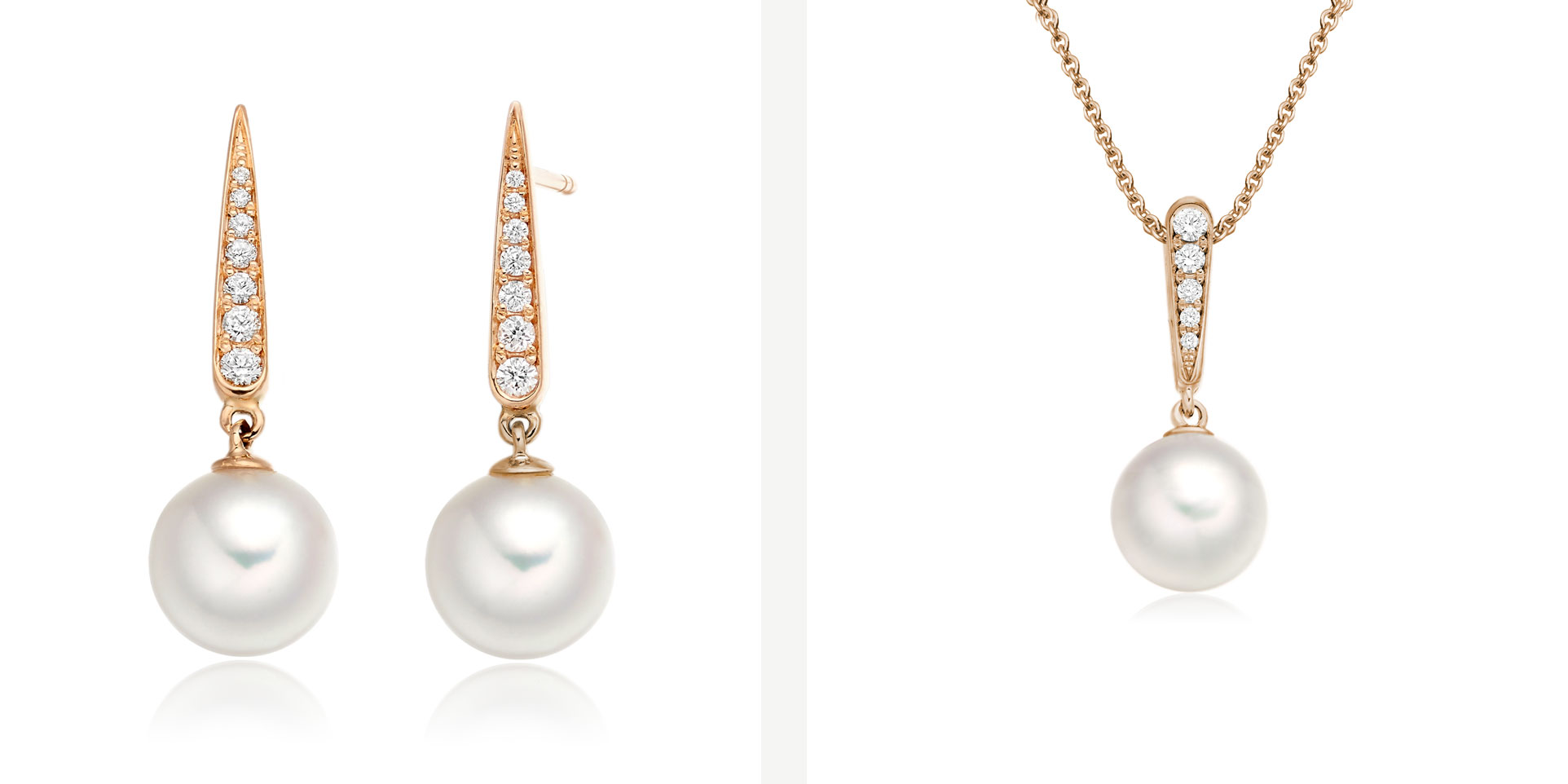
Image 1: Mythologie Dewdrop Akoya Pearl Earrings in Rose Gold
Image 2: Mythologie Dewdrop Akoya Pearl Pendant in Rose Gold
Hindu folklore refers to the pearl as a dewdrop, falling from the night sky into the moonlit sea, where Krishna, the god of love, plucks it from the ocean floor as a bridal gift for his daughter. Show your love for that special someone with a stunning new Mythologie Dewdrop set this Christmas.
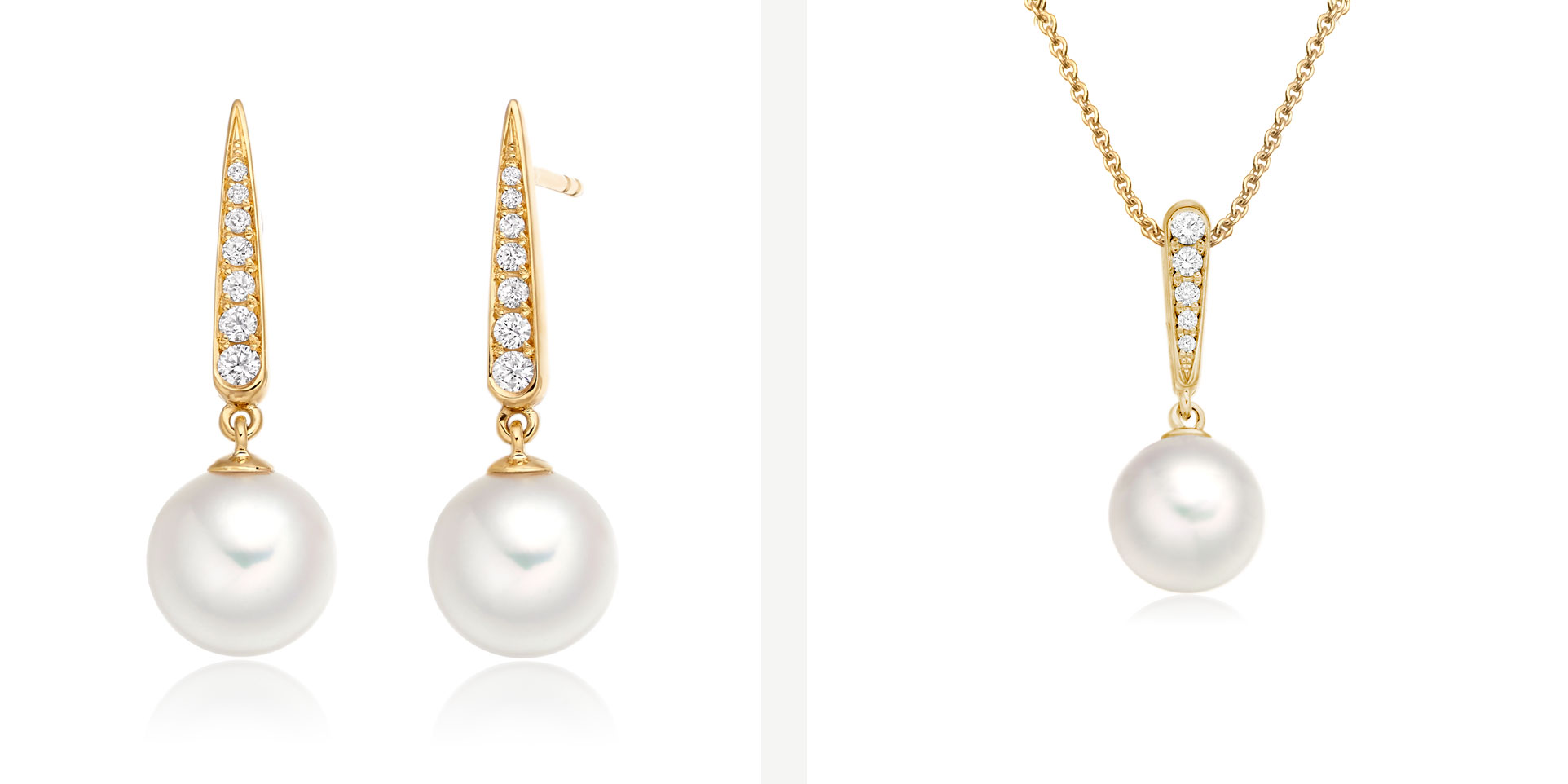
Image 1: Mythologie Dewdrop Akoya Pearl Earrings in Yellow Gold
Image 2: Mythologie Dewdrop Akoya Pearl Pendant in Yellow Gold
Each elegant Dewdrop is crafted with a beautiful Akoya pearl, topped by a pave of brilliant cut diamonds, and hand finished in 18 carat white, yellow or rose gold.
A special Dark Dewdrop design is now also available, with the natural tones of Tahitian pearls that are perfect for the evening. -
Winterson Prize 2018: Meet the Designers Part II
Winterson Prize 2018: Meet the Designers Part II
Each year we work with the student jewellery designers at Central Saint Martins in London, giving them an opportunity to experience designing with pearls for their final year collections.
We will be awarding the Winterson Prize 2018 to one of the students for ‘The Best Use of Pearls’ at the CSM Jewellery Awards Evening on 21st June. The BA Jewellery graduate collections are exhibited at CSM and open to the public from June 20th - 24th.
Here we feature the first part in a series of short interviews with designers from the CSM Jewellery 2018 show, including in this article - Geraldine Wu, Hannah Cochrane, Isla Gilham, Yayun Fang and Yichen Dong.
Read about the other designers in Part I and Aidan Madden, the winner of this year's prize.

Geraldine Wu
Tell us a little bit about yourself.
I am from Hong Kong and have lived in London for 4 years now. Being immersed in such busy and diverse places my whole life, I can’t be away from the city for too long. I love living in a place where I can experience the past and the present all at once.
What was the inspiration for the 'Ocean Archives' collection?
I was inspired by illuminated manuscripts and their purpose of being visually decorative to ornament text, painting a fuller picture of the story. I wanted to create jewellery that would emulate a similar effect, with the narrative that the collection is a rediscovered treasure hoard. Hence there is an archaic, medieval influence within the designs.
What do you find inspiring about pearls?
I find pearls very poetic. They are quieter and more understated than faceted stones, they allow their soft lustre to speak for themselves. In a sense, they are not competitive for attention, but know their worth. Also given that they originate from bodies of water, they are very fitting within my collection.
What have you discovered about working with pearls?
I discovered that laser engraving them results in an iridescent powdery finish. My favourites were the dark baroque pearls, as the silvery/golden finish stands out most against the dark surface. I love that it looks like the text is stuck within the pearls, suspended in time.
Which designer or artist do you most admire?
Renaissance painters such as Raphael and Botticelli, I’m always in awe of the juxtaposition of dynamism and restraint in Renaissance paintings.
Who could you imagine wearing your jewellery?
Anyone expressive and likes to curate their own story or character through their dressing.
What is it that makes a piece of jewellery a design classic?
A design that withstands the test of time, something that people always return to.
What’s next for you after CSM?
To learn within the industry and develop my skills as a jewellery designer.
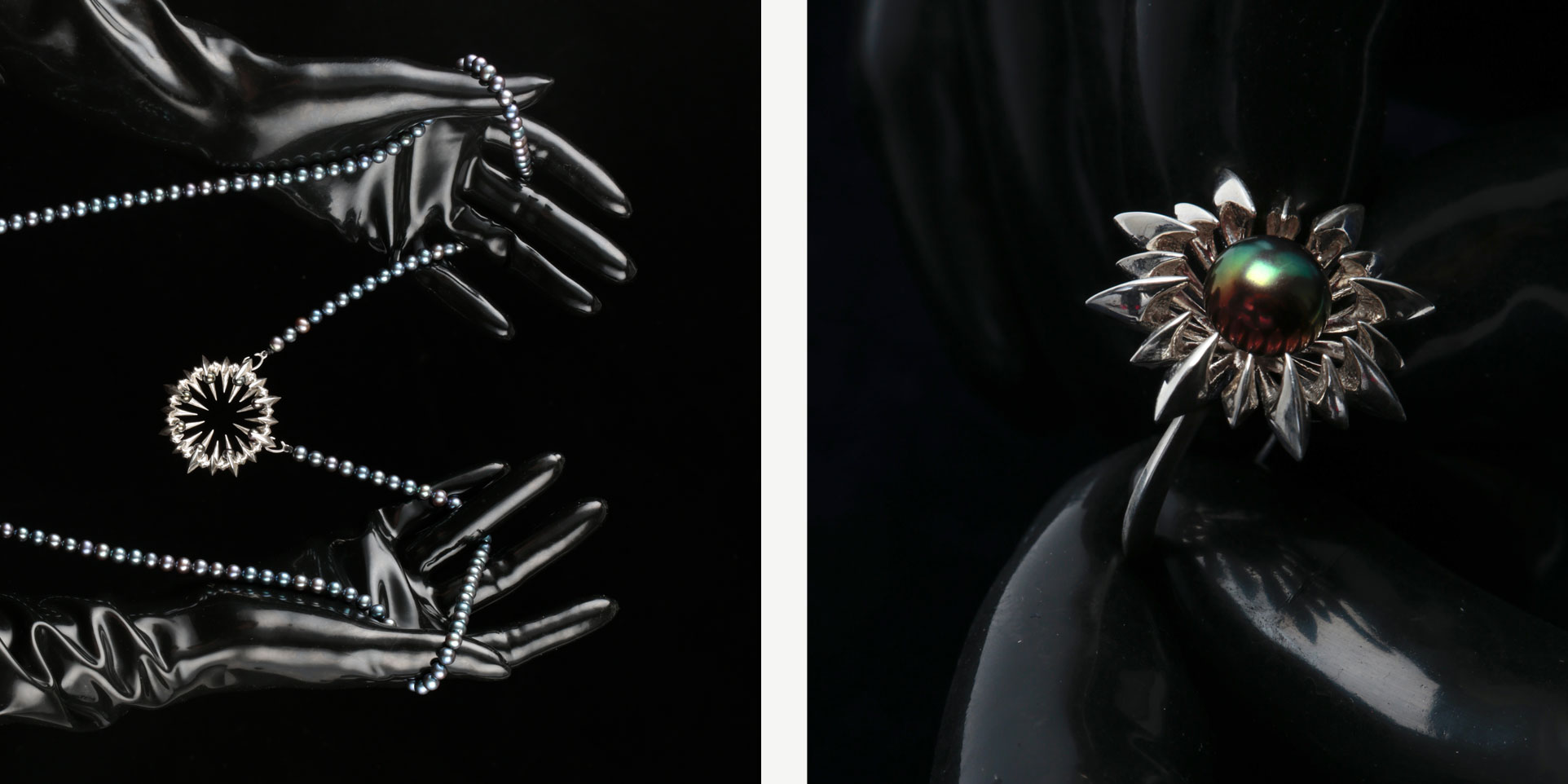
Hannah CochraneTell us a little bit about yourself?
I have always been fascinated by jewellery, from the child who eagerly inspected the fine jewellery adverts plastered around Geneva airport, to the adult who spends far too much time staring at other people’s jewellery on the tube.
What was the inspiration for the 'A Sharper Image' collection?
Inspired by concepts put forward by the field of neuroaesthetics, I researched visual elements and design techniques that would re-occur again and again within jewellery from different countries and cultural backgrounds. An example of this was threading teeth and bone structures together to form cohesive strands. Through analysing different threads of aesthetic preference, I condensed these into a visual style that aligned with my own.
What do you find inspiring about pearls?
To me, the pearl echoes of the first instances of jewellery making: the gathering of beautiful natural objects and using them as adornment.
What have you discovered about working with pearls?
I wanted the otherworldly colour shifts found in some pearls I acquired to be displayed in the best way possible. I found the best way to do this was to find said pearls and then design around them, specifically tailoring the original metal design around it.
Which designer or artist do you most admire?
Too many to count, but currently transfixed by Fernando Jorge's alluring designs.
Who could you imagine wearing your jewellery?
Quite honestly? Myself.
What is it that makes a piece of jewellery a design classic?
A piece that people remember, not necessarily because it might be unique or groundbreaking, but because it lingers on the mind, long after first seeing it.
What’s next for you after CSM?
I plan to look for experience and work within the field of jewellery.
View more of Hannah's work here.

Isla Gilham
Tell us a little bit about yourself.
Five years ago, I came across a jewellery workshop on the isle of Iona. The pieces reflected and told stories of the island; Celtic patterns, Serpentine pebbles, coastlines and simplistic beauty; It was at this moment, that I knew I wanted to create jewellery too.
What was the inspiration for the 'Temptation' collection?
The cherished family story of my Great-Grandad’s Jelly Tot tiara.
What do you find inspiring about pearls?
That they embody the idea of beauty in an unexpected place; inside a mollusc’s shell. A concept I have taken for my chewing gum, usually seen to be disgusting, adorning the streets.
What have you discovered about working with pearls?
The beauty of laser engraving their surface! It reveals more beautiful tones and has an almost holographic quality.
Which designer or artist do you most admire?
Many, however, this year, I’ve really admired and taken inspiration from Dutch Golden Age paintings which ‘shout’ indulgence and opulence. The paint captures the deliciousness of food in still lives as I try to with precious materials.
Who could you imagine wearing your jewellery?
Anyone who loves the concept of beautiful, elegant materials but with a playful twist.
What is it that makes a piece of jewellery a design classic?
I think a piece that captures the imagination whilst reflecting and ‘centre staging’ the materials used.
What’s next for you after CSM?
To keep designing, making and being excited by jewellery!

Yayun Fang
Tell us a little bit about yourself.
My name is Yayun. As a jewellery designer, I love working with different materials and exploring the traditional craftsmanship practices in my jewellery. One of my biggest pleasures is seeing people wear a piece of jewellery I made and feeling good wearing it.
What was the inspiration for the 'Hip-Hop Lace' collection?
A combination of delicate lace from old master paintings and bold hip-hop jewellery styles are the main inspiration for this collection.
What do you find inspiring about pearls?
I love the alluring shine and elegant colour. I never get tired of looking at pearls or mother-of-pearl as they always have different shades, colour and shine.
What have you discovered about working with pearls?
Pearl accessories always appear along with lace pieces in old master portraits, they both share the same language of delicacy and elegance. In my final collection I wanted to design pieces with both boldness and delicacy. Mother-of-pearl as a material offers me the biggest surface to apply the lace patterns with the way I join them together, which allows me to create a bold yet elegant feel.
Which designer or artist do you most admire?
Andrew Grima.
Who could you imagine wearing your jewellery?
Confident and fearless people.
What is it that makes a piece of jewellery a design classic?
Highlight the best characteristics of a material and approach it in an unexpected and unique way.
What’s next for you after CSM?
I would like to further my career as a jeweller and aim to join the design department of a jewellery company.
View more of Yayun's work here.
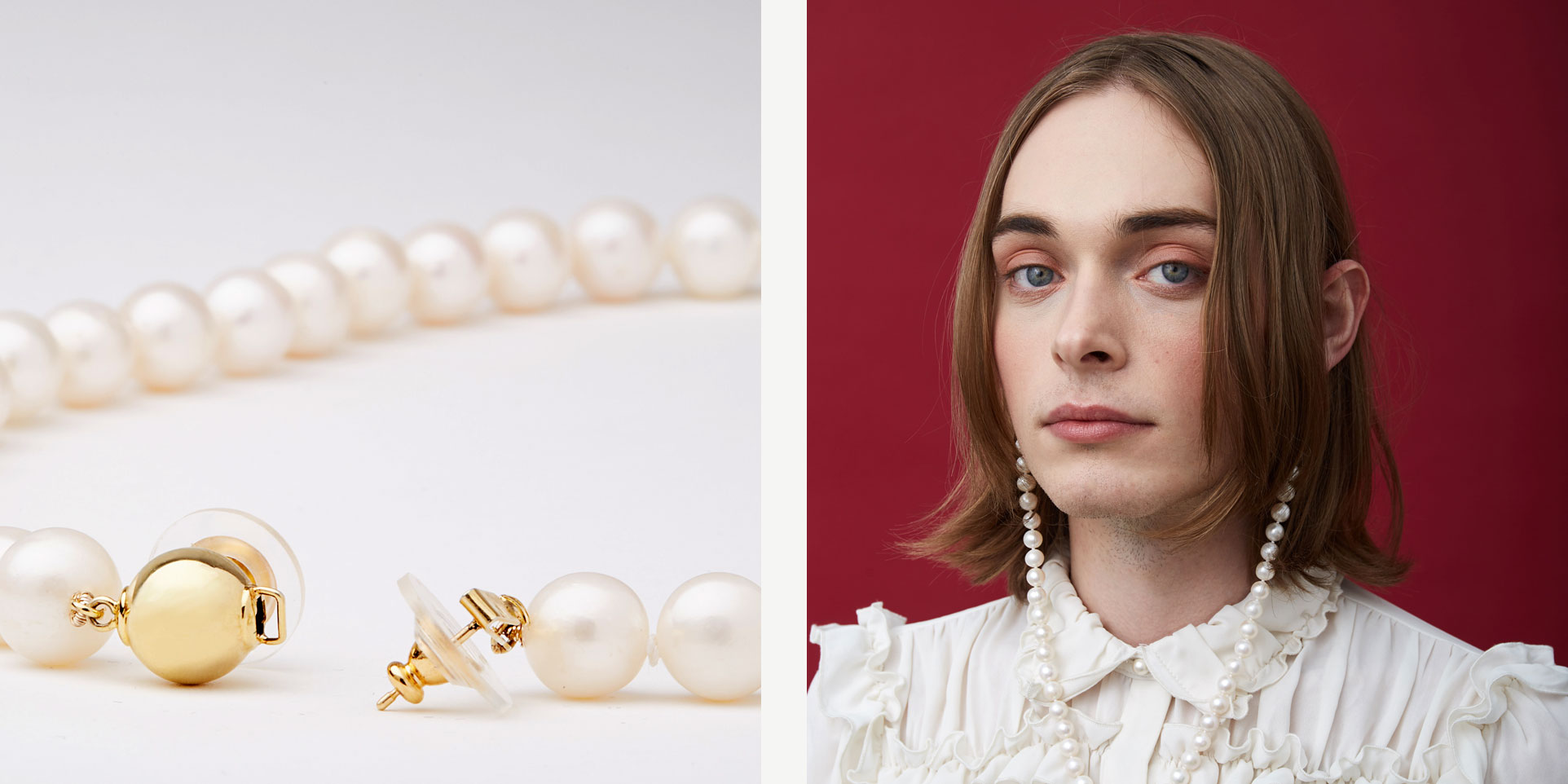
Yichen Dong
Tell us a little bit about yourself.
I am from China. I like witty and unexpected contemporary designs, and to think conceptually.
What was the inspiration for the 'Be who you want to be’ collection?
I was inspired by stereotypes around transgender, transvestism, LGBT and roles of each gender. I admire those people who are brave enough to express their true identity.
What do you find inspiring about pearls?
To use pearl as a metaphor and a response. I found pearls necklace represent purity and elegance in commonsense, and I am interested in creating contrasts and bring the pearl out of this ‘stereotype’.
What have you discovered about working with pearls?
The single pearl can be a jewellery piece with many possibilities. The colour, its glow and shape can tell lots of stories.
Which designer or artist do you most admire?
Akiko Kurihara. Her works are witty, clever and unexpected with a great sense of humour.
Who could you imagine wearing your jewellery?
People who need encouragement to express identity and to find who they are.
What is it that makes a piece of jewellery a design classic?
The relationship between materials and the story behind the jewellery makes a piece classic and unique.
What’s next for you after CSM?
I’ve got offer and will continue jewellery study in RCA.
View more of Yichens's work here. -
Winterson Prize 2018: Meet the Designers Part I
Winterson Prize 2018: Meet the Designers Part I
Each year we work with the student jewellery designers at Central Saint Martins in London, giving them an opportunity to experience designing with pearls for their final year collections.
We will be awarding the Winterson Prize 2018 to one of the students for ‘The Best Use of Pearls’ at the CSM Jewellery Awards Evening on 21st June. The BA Jewellery graduate collections are exhibited at CSM and open to the public from June 20th - 24th.
Here we feature the first part in a series of short interviews with designers from the CSM Jewellery 2018 show, including in this article - Aidan Madden, Bam Jansanjai, Beichen Guan, Biying Chen and Gabriella Goldsmith.
Read Part II of this series and about Aidan Madden, the winner of this year's prize.

Aidan Madden
Tell us a little bit about yourself.
I sit somewhere between contempory and fine jewelry. I appreciate tradition, but like to turn it on its head.
What was the inspiration for the 'Pearl Culture' collection?
Initially, I had no interest in pearls. This was a good starting point, as I hadn't any preconceptions of how they should be represented. This pushed me to change them significantly through unconventional methods.
What do you find inspiring about pearls?
I find there is much more potential as a material rather an embelishment. Once you begin to cut and join them they have infinite potential.
What have you discovered about working with pearls?
Exposing the pearls' nucleus is what drew my attention, prompting the series of ‘pearl faces’ and pearl tubes.
Which designer or artist do you most admire?
Taffin and Hemmerle; they do things differently and have an experimental way of working with materials.
Who could you imagine wearing your jewellery?
My collection is playful and diverse so I feel it will reach out to a broad spectrum of people.
What is it that makes a piece of jewellery a design classic?
A design that transcends the current trends.
What’s next for you after CSM?
I would like to continue working with pearls and expanding on my collection.
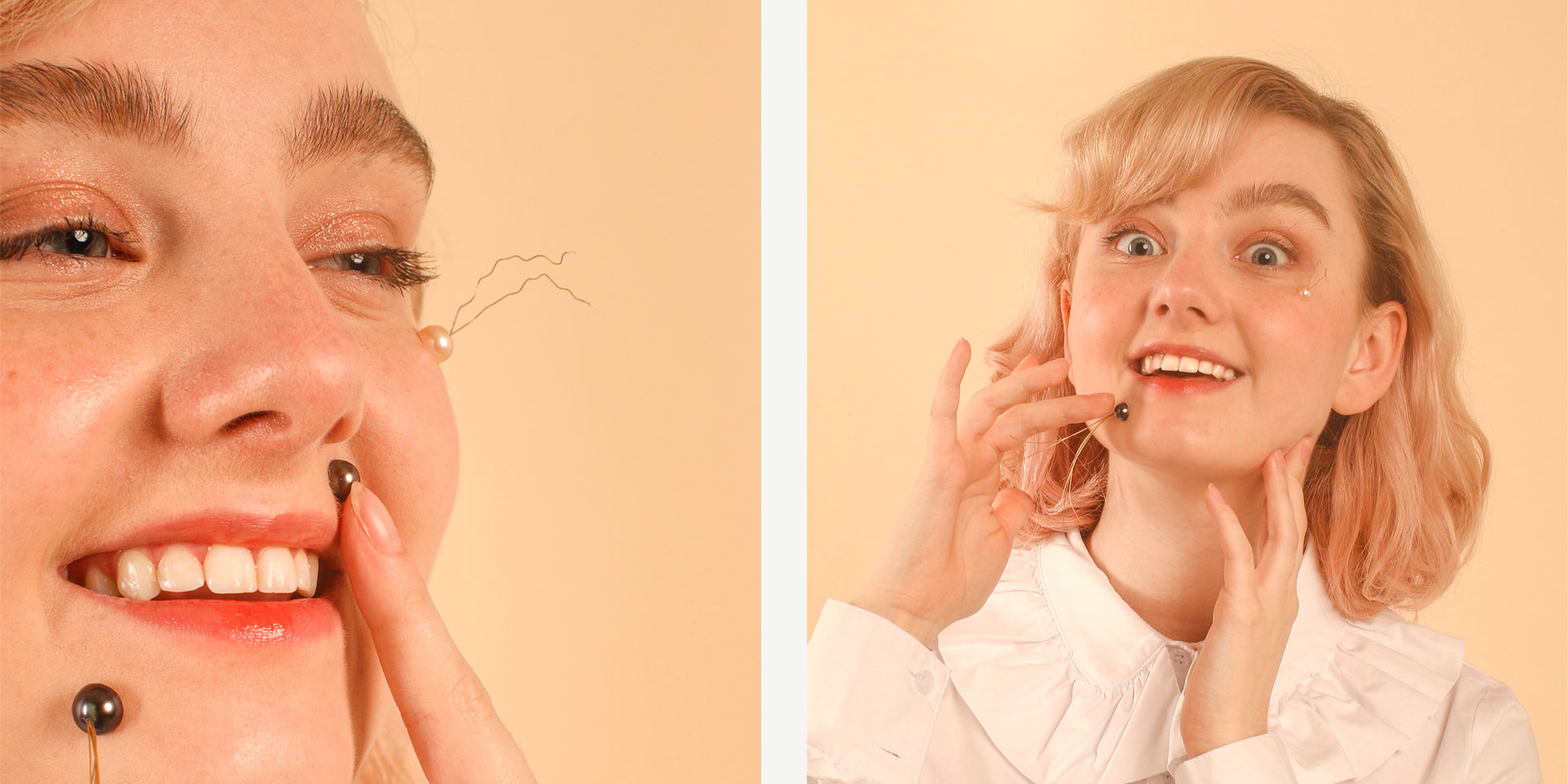
Bam Jansanjai
Tell us a little bit about yourself.
I like working in positive, playful and unique designs with different materials creating jewellery with stories. So my jewellery is the way that I express myself to other people.
What was the inspiration for the 'How to Wear Good Luck' collection?
I think it is very interesting how people give objects the meaning and value that represent something spiritual and how one object can mean something to someone. So I wanted to explore a context of jewellery that is more than just an adornment, a jewellery that brings luck to the wearers or at least brings a positive energy to them. This collection is inspired by 13 old good luck superstitions that are converted into a wearable jewellery in modern context.
What do you find inspiring about pearls?
One of the pieces in my collection is called “Magic Mole”. People believe that moles indicate luck so I made pearl moles that ones can stick on their faces in the position where they want to enhance the luck. So I want to add value to the mole and to emphasize their specialness with pearl.
What have you discovered about working with pearls?
Pearls are very fragile. Working with them required a lot of patience but it somehow gave me calmness.
Which designer or artist do you most admire?
Alessandro Michele.
Who could you imagine wearing your jewellery?
Everyone. Basically, anyone who wants to brighten up their day with a little help from good luck jewellery.
What is it that makes a piece of jewellery a design classic?
The concept and a good design that capture everyone’s attention.
What’s next for you after CSM?
For me, being successful in competitive world of design requires a lot more than just design skills. So I have decided to do MA in Luxury Brand Management.
View more of Bam's work here.
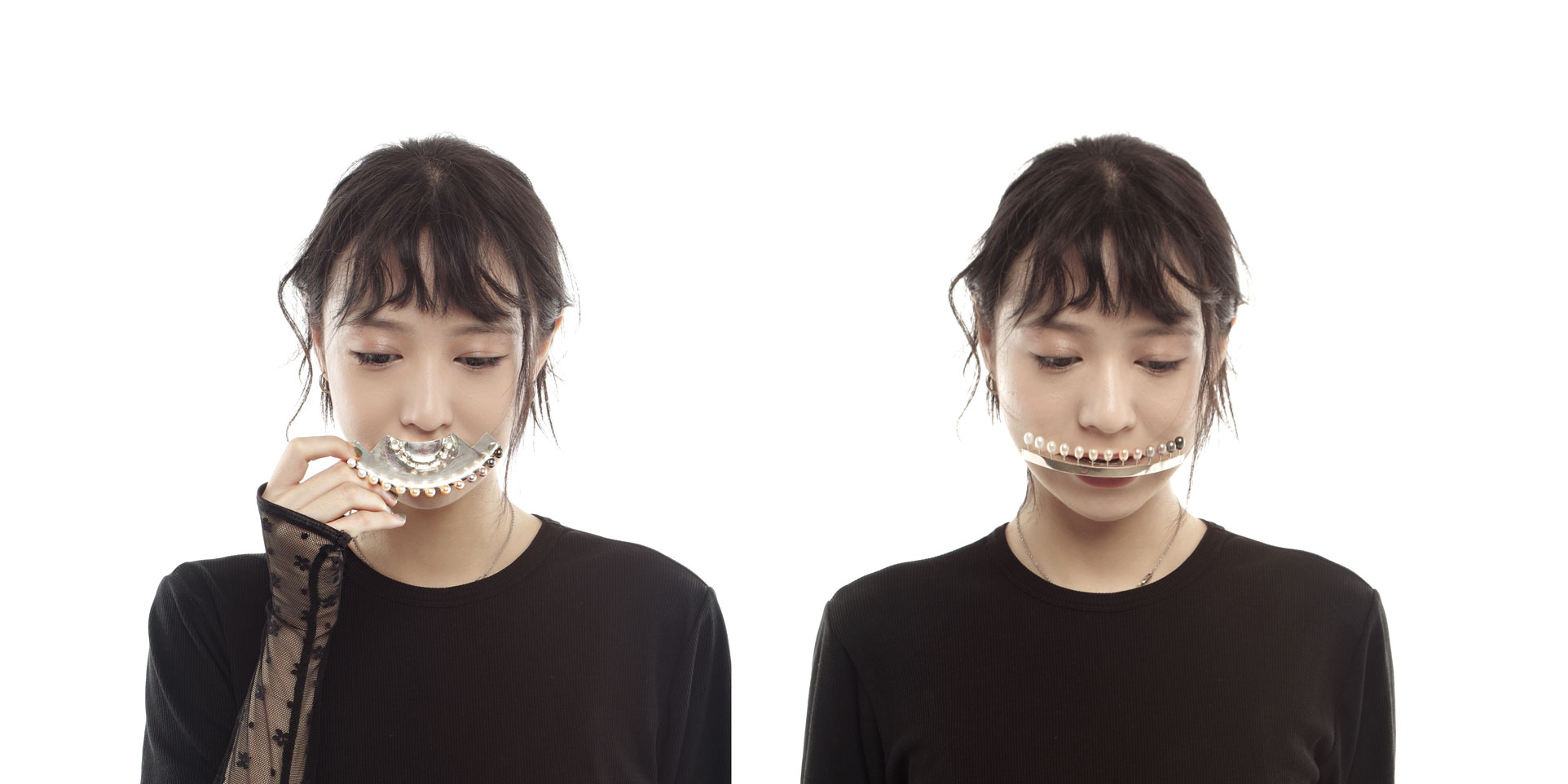
Beichen Guan (Esther)
Tell us a little bit about yourself.
I am a Chinese student who has studied in Central Saints Martin BA Jewelry Design for 3 years. I am super interested about Architectural design and Installation art, it also can be a skill in several artistic mediums.
What was the inspiration for the 'Ultra Sparking Smiles' collection?
For this collection, inspired from the star pattern of “emoji ” that people easily can understand, into those teeth whitening products and tools. In a entertaining way to show people just like me who try so hard to whiten their teeth because of the aesthetic feeling pressures from society.
What do you find inspiring about pearls?
Lots of people adore the pearly whitened teeth that those Hollywood stars have after 2000. I am trying to find the way to showing my feeling of teeth whitening industry as jewelry designer. The variety of a pearl’s shape and color make a really good figure of human teeth.
What have you discovered about working with pearls?
I try to used mother of pearl carving skills to cut out a rhombus shinning pattern that describes the message of dental teeth whitening. Also I using graduated color to represent the different aesthetic varieties of subcultures related to the teeth whitening.
Which designer or artist do you most admire?
I find such designers brand as Ambush, Dubellier and Schield to be highly inspiring and contemporary.
Who could you imagine wearing your jewellery?
This collection is quite personal as it's my point of view. It's talking about the people who like me, wish to whiten their teeth to have the pearly shining teeth like those stars have.
What is it that makes a piece of jewellery a design classic?
Probably just like Melvyn Kirtley, Tiffany chief gemologist said, “ always pushing the boundaries of innovation, and doing things that we’ve never done before.”
What’s next for you after CSM?
I will try to do some internship jobs after I graduate, to learn more things outside of college.
View more of Beichen's work here.
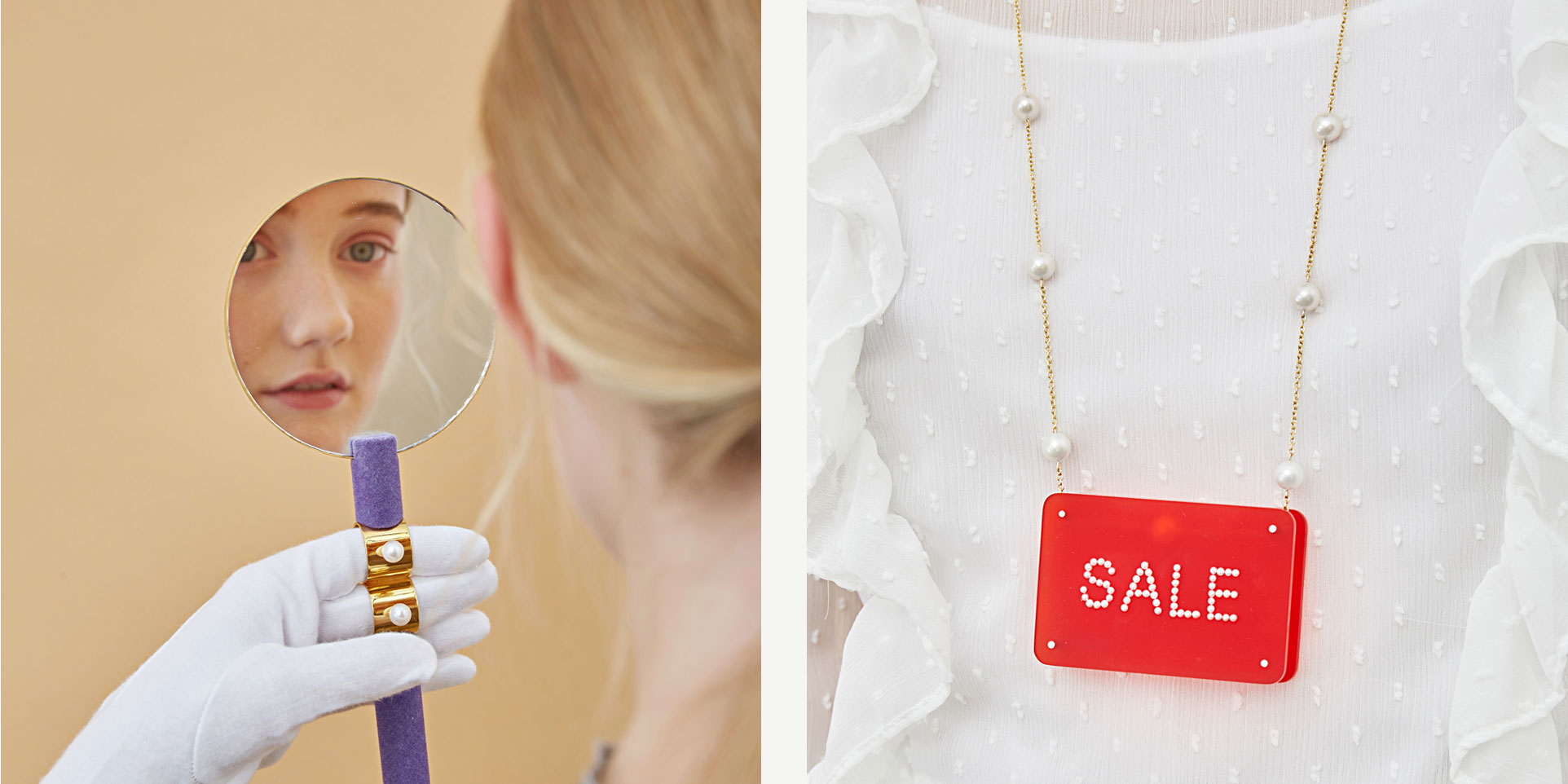
Biying Chen
Tell us a little bit about yourself.
My name is Biying and I am from China. My jewellery always has a strong interaction with the wearer.
What was the inspiration for the 'Jewellery Shop' collection?
I found customers’ and salesperson’s attitude to display items were entirely different during my work experience in 2016, which led me think about the value of display props.The comparison of the shop window in the day and night was my direct inspiration. At night, jewellery pieces are often removed and stored for safety. It seems that the display props become the protagonist in the showcase.In this collection, I used the preciousness of pearls to question and highlight the value of display props.
What do you find inspiring about pearls?
Pearls are not as aggressive as other gemstones. With their natural, random lustre and general relatively smooth edges, for me, pearls can reflect the softness of femininity.
What have you discovered about working with pearls?
Although not all the pearls are exactly the same size when I ask a specific size in the shop, I find it even more natural which gives a contrast to the precise machine work.
Which designer or artist do you most admire?
Otto Künzli and Giorgio Morandi.
Who could you imagine wearing your jewellery?
Energetic and playful people.
What is it that makes a piece of jewellery a design classic?
The particular concept behind a piece is the most crucial factor.
What’s next for you after CSM?
I woud like to learn more about the jewellery industry and start to set up my own business.
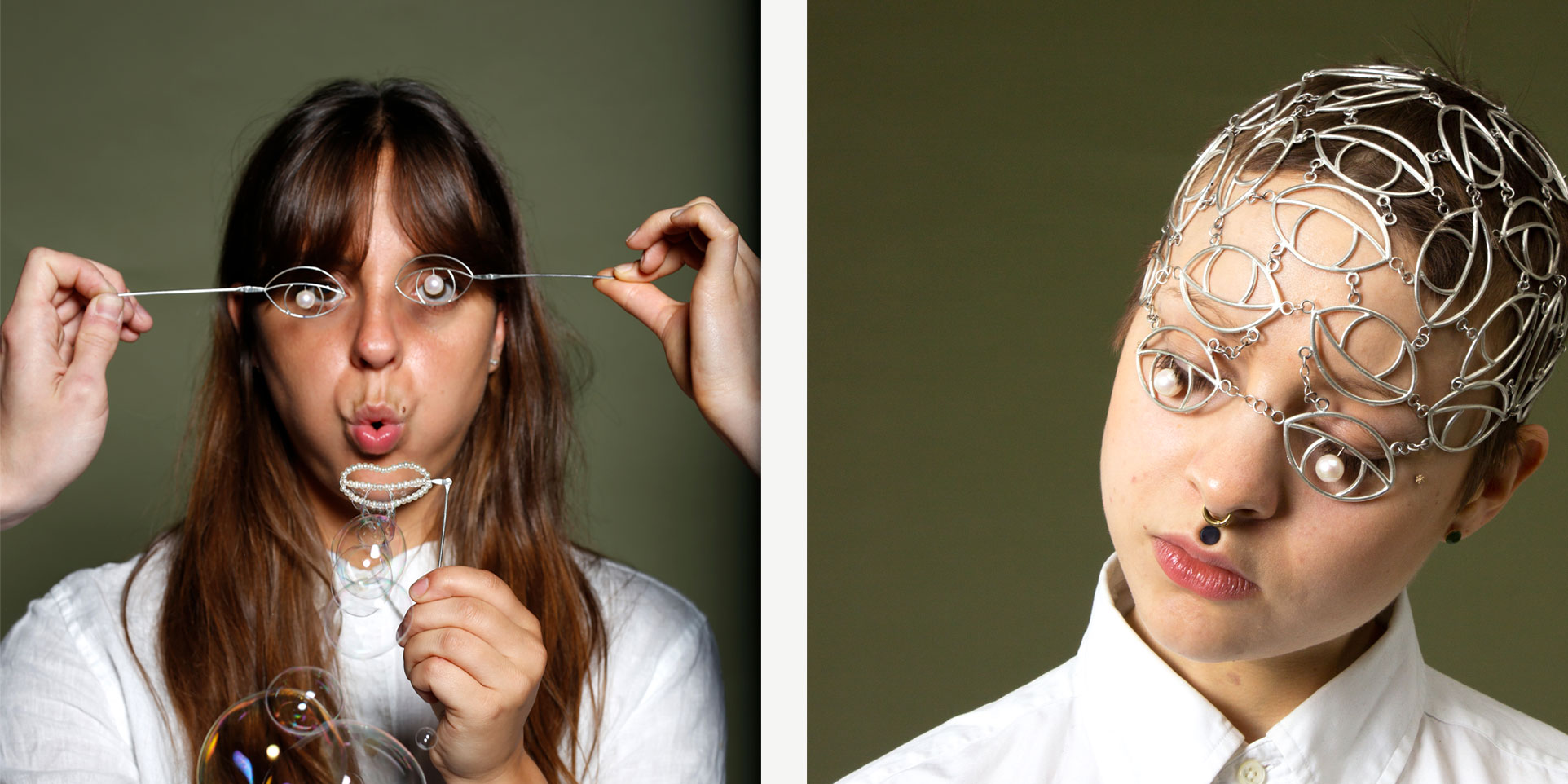
Gabriella Mika Goldsmith
Tell us a little bit about yourself.
I was born and raised in Denmark. With an American dad and a Danish mom, I always felt the need of travelling which eventually led me to move to London to continue my further education. I have found that studying jewellery and living in London has given me the insight to a world of wonderful odd eccentrics and charismas.
What was the inspiration for this collection?
The collection reflects on my inner sub-conscious that allows to dream away by presenting identity’s different from the one you see in real life thus the facial features presented throughout the work. I was inspired by the thoughts behind surrealism and therefor the bubbles have become an instrument to allow one to sooth away by recapturing childhood moments disturbing the rational.
What do you find inspiring about pearls?
Each cultured pearl is unique, and I find it fascinating how we can use these water-made species in our jewellery. They are subtle but have a beautiful glaze with their skin like colours.
What have you discovered about working with pearls?
That they are extremely fragile, that there are so many different types of “real” pearls, and that they shouldn’t be regarded as a conservative jewel!
Which designer or artist do you most admire?
Tone Vigeland and Alexander McQueen – and so many others!
Who could you imagine wearing your jewellery?
Anyone who are willing to challenge conventional jewellery and has an appreciation for the craft.
What is it that makes a piece of jewellery a design classic?
A design that everyone can appreciate, is timeless with the highest level of craftsmanship.
What’s next for you after CSM?
I have just been accepted for an MA at Sandberg Institute in Amsterdam.
View more of Gabriella's work here. -
What are the classic jewellery designs for pearls?
What are the classic jewellery designs for pearls?
It has long been known that the pearl has played a central role in jewellery, with some of the earliest recorded fragments of a pearl necklace being dated to the 4th century BC. What are the most popular and successful designs of classic jewellery that pearls have been used with - and how are they being updated today?
The pearl was believed by numerous cultures to symbolize purity and to offer protection, as well as being indicative of their owner’s social position. Their beauty and rarity meant that the gems held an almost mythological, and certainly significant financial status.
The Timeless Classic
There are many examples through the ages of how our love for the pearl has influenced the wearing, adornment and design of the classic jewellery that we love today.
In China as early as 2300 BC, pearls were considered appropriate gifts for royalty, representing not just the integrity and loyalty of the giver but also the wisdom and virtue of the wearer. Julius Caesar passed a law in the 1st century BC, which determined that pearls should only be worn by the ruling classes.
In India, it is still believed that the pearl confers calm on its wearer, attracting wealth and good luck. The gem was a favourite of Indian royalty, most notably the Mahraja Khande Rao Gaekwad of Baroda, whose seven-strand necklace was legendary even within a culture where extraordinary gems were plentiful – so much so that the famed necklace gained a name of its own: the Baroda Pearls.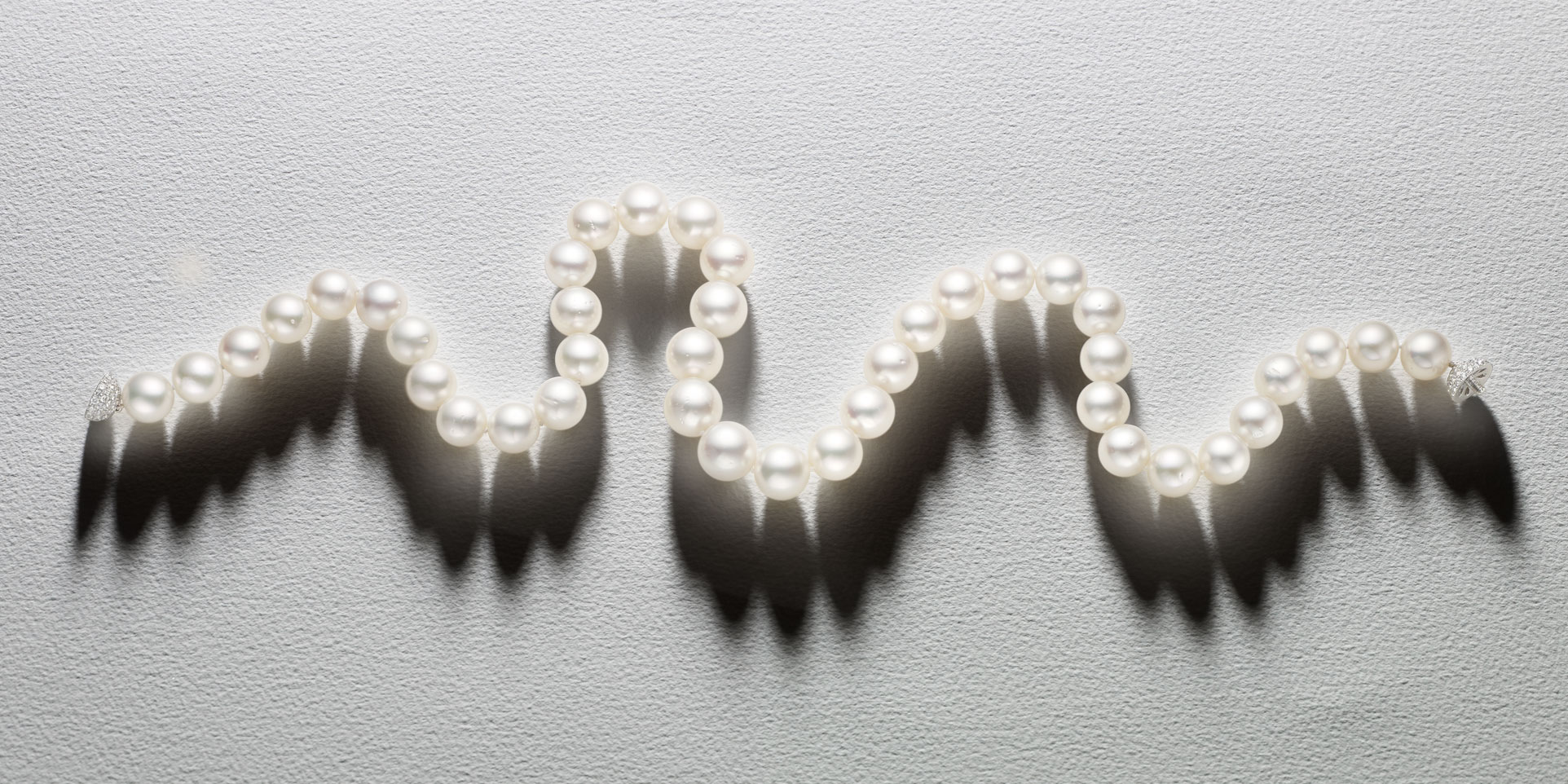
Image: A Winterson South Sea pearl and pave diamond clasp necklace
Their extravagant value lead to the pearl playing an important role in trade, which only increased once they were discovered in Central and South America in the 15th century, a discovery which led to the so called Pearl Age.
As a visible symbol of wealth, the demand for pearls escalated, particularly in Western Europe, where royals and aristocrats increasingly emulated their peers in China, India and the Arab states, commissioning elaborate pearl necklaces, earrings, bracelets and brooches.
By the 19th century, demand for pearl jewellery was so high that the supply of natural pearls began to dwindle to the point today where historic pieces of natural pearl jewellery are so rare they can fetch high six or seven figure sums at auction.
The Pearl Necklace
As a result of the way that they reflect light to the face, strands of pearls have become the most popular form of classic jewellery over the ages. The more strands in a necklace, the greater that the necklace reflected the wealth of its owner.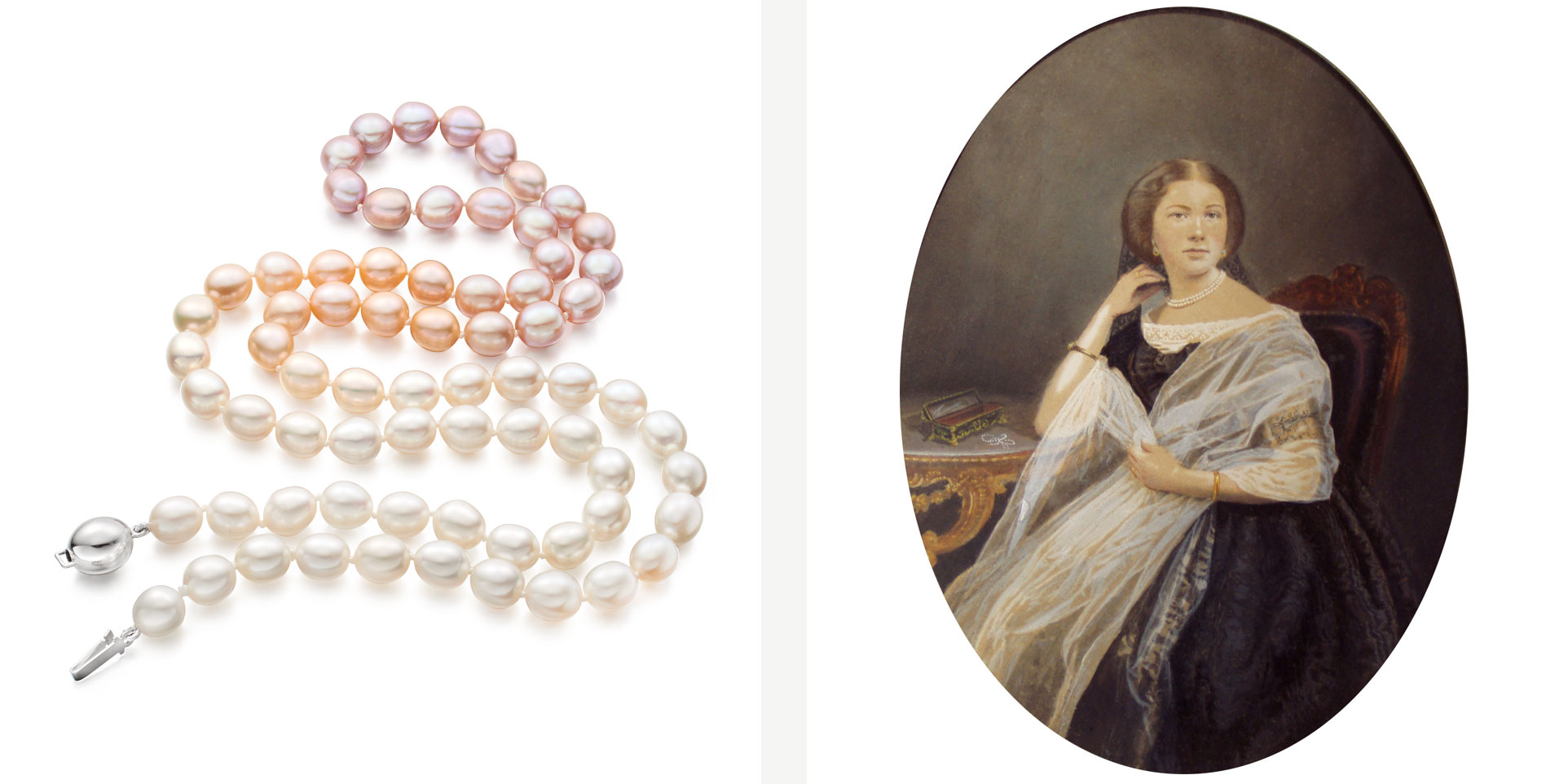
Image 1: Blush Sunrise Necklace
Image 2: A portrait miniature of Emma Ostaszewska née Countess Załuska, ca. 1850s
The lustre of the gems was often preserved by having Victorian maids wear the necklaces during the day to keep the pearls warm and radiant for their mistresses.
With the arrival of the cultured pearl, the status of the gem has shifted over the 20th century, becoming more widely accessible. The multi strand pearl necklace remains an enduring piece of classic jewellery that actresses, society ladies, designers and jewelers such as Winterson prize winner Bella Mung continue to revisit.
Our pearl specialists individually select and grade each strand that makes up a Winterson necklace, often viewing and reviewing pearls throughout the day to be aware of the impact of shifting light on the overtones and lustre of the pearl. Our necklaces are available in multiple lengths, colours, and different types of pearls, including Akoya, Freshwater, South Sea and Tahitian. Read our Buying Guide to choosing a necklace to learn more.
The Pearl Stud
After the pearl necklace, pearl studs form another cornerstone of a woman’s classic jewellery wardrobe. The legendary Coco Chanel was well known for her enduring love of these beautiful gems,which she wore prodigiously (real and fake together).
Although she favoured the monochrome white pearl necklace, once famously declaring “a woman needs ropes and ropes of pearls", her single pearl clip earrings were almost as significant a part of her iconic image.
Image 1: Pocket watch of gold, with enamel and oriental pearls, 1800
Image 2: Green Grey Tahitian Pearl Stud Earrings in Rose Gold
The pearl studs at Winterson are available in a wide choice of colours, sizes from 6-12mm , types of pearls and finished with 18 carat white, yellow and rose gold earring posts and butterflies.
The Pearl Drop Earring
In an era where natural pearls, with all their unique forms and qualities, were the stones that were used in classic jewellery, the popularity of the drop shape is unsurprising. Vermeer’s famous Girl with a Pearl Earring provides the archetypal blueprint for the freshwater drop earring, a classic style that has most recently been adopted by the current Duchess of Cambridge.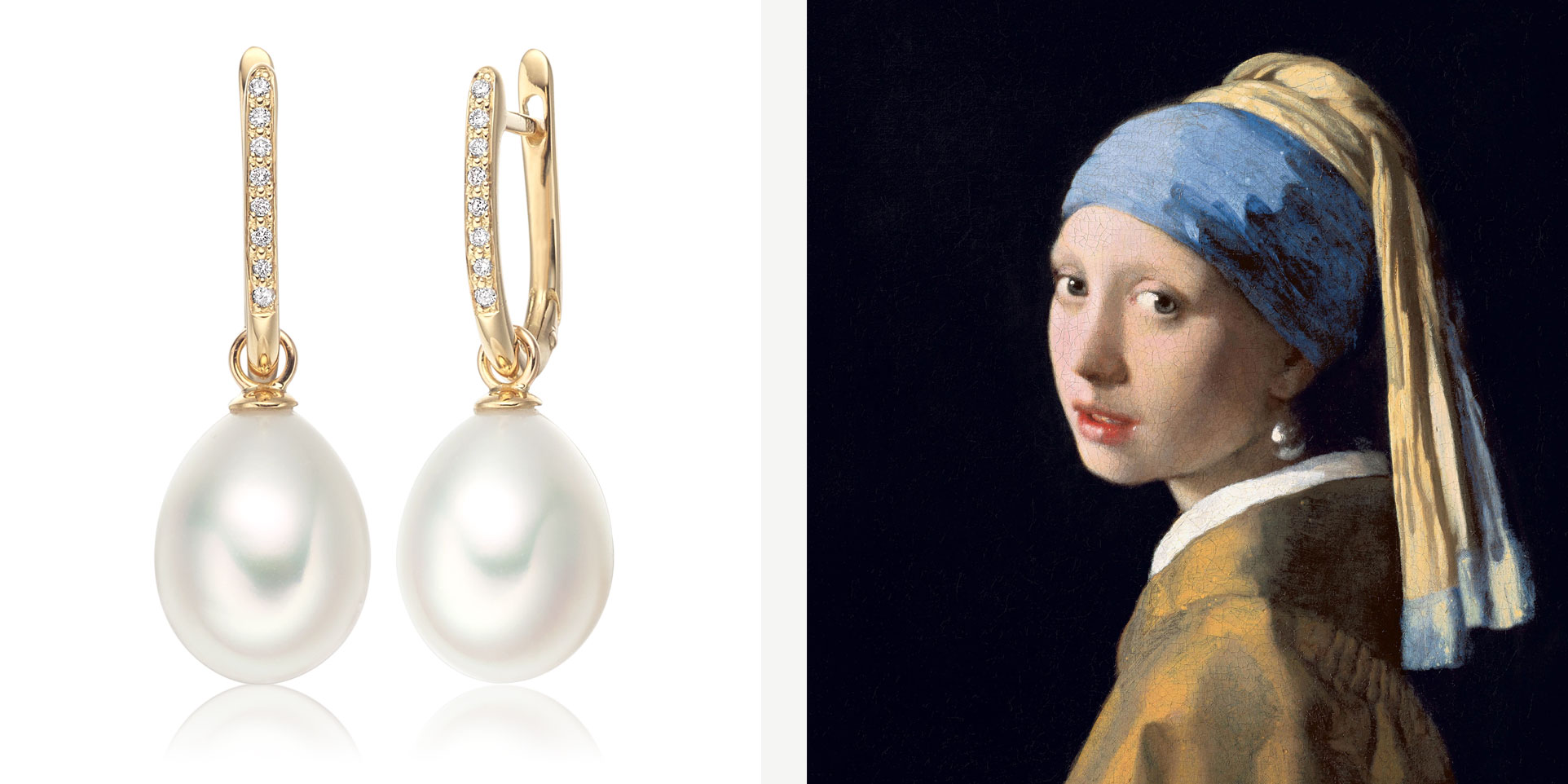
Image 1: Yellow Gold Diamond Leverback And Freshwater Pearl Drop Earrings
Image 2: The Girl With The Pearl Earring, Johannes Vermeer, 1665
Natural pearl drops continue to fetch high sums at auction, as the sale of a pair of earrings owned by Empress Eugenie of France, wife of Napoleon Bonaparte, amply demonstrated. Fetching $3.3 million, the drops were then promptly reset for their new owners by American high jeweler Lee Sieglson, reflecting that the value was paid for the pearls rather than their original setting.
The Seed Pearl Ring
Seed pearls gained popularity in Georgian and Victorian jewellery, where they often accented the frame of rings and earrings in the same way that diamond pave does today.
Image 1: Funeral Ring, Landscape and Temples, 18th Century
Image 2: Beau Seed Pearl and Enamel Ring with Yellow Gold
Often seen as part of mourning jewellery, set around painted portraits or landscapes or offset by washes of enamel, this era of jewellery formed the basis of inspiration for Alice Cicolini’s Beau collection for Winterson.
The Pearl Brooch
Seed pearl pave, where lines of these wonderful tiny pearls are set in single or multiple rows, also offered a stylish way for jewellers to incorporate the pearl in brooches. This form of jewellery became highly popular in the 19th century as a decorative jewel, rather than as a functional object which was the original purpose of the brooch.
Although their popularity has waxed and waned over the years, it appears as if the brooch may be increasing in popularity again as fashion brands and jewellers alike seek new surfaces for jewels to come alive.
Perhaps pearls may also find their way onto these new generation designs. The Duchess of Cambridge might have recently signalled the reinvention of this classic jewellery design at a recent state visit, wearing the Queen’s triple pearl and diamond leaf pearl brooch with the stunning Collingwood Pearl and Diamond drop earrings which she often favours. -
The spectacular rise and style of Rose Gold
The spectacular rise and style of Rose Gold
What do Apple, Birkenstock, Beats and Hervé Léger all have in common? They have all succumbed to the appeal of a material that jewelers have long celebrated – rose gold.
Now a major colour trend across homeware, technology and accessories, rose gold adorns products that are as diverse as Wet N Wild lip gloss and the iPhone. Recognising its popularity, in 2016 the Pantone Institute chose a blend of warm Rose Quartz with a more tranquil Serenity blue as its Colour of the Year, influencing product design and direction.
What is rose gold?
Rose gold is a composite gold alloy of 75% yellow gold, 22.25% copper and 2.75% silver. It finds its purest form as Crown Gold, a 22 carat mix of 91.667% yellow gold and 8.333% copper. This alloy has been used to mint British Sovereign coins since Henry VIII introduced it in 1526.

Image 1: Zigzag Diamond Pendant
Image 2: Pair of Zigzag Diamond Earrings with Akoya Pearls
Variations such as pink and red gold arise from modifications to the amount of copper and silver that are added to the mix, either amplifying or lightening the dusky rose tones.
What are its origins?
The history of rose gold also finds an echo in its last golden age: in Imperial Russia at the beginning of the twentieth century. Royal jeweler, Carl Fabergé, popularized the metal as a royal favourite, creating some of his most ornamental pieces in delicate blush tones.
Most famously, the “Moscow Kremlin” egg was commissioned by Emperor Nicholas II as a gift for his wife. The gold and white enamel egg was housed within a miniature replica of Red Square’s fifteenth century Spasskaya Tower and, at 11,800 rubles, was one of Fabergé’s highest value commissions.
Rose gold rising
Symbolism is undergoing a significant and seemingly unstoppable popular revival, particularly in jewellery. The emotional impact of its colour, with all its myriad interpretations and meaning, is widely studied by designers and marketeers alike.
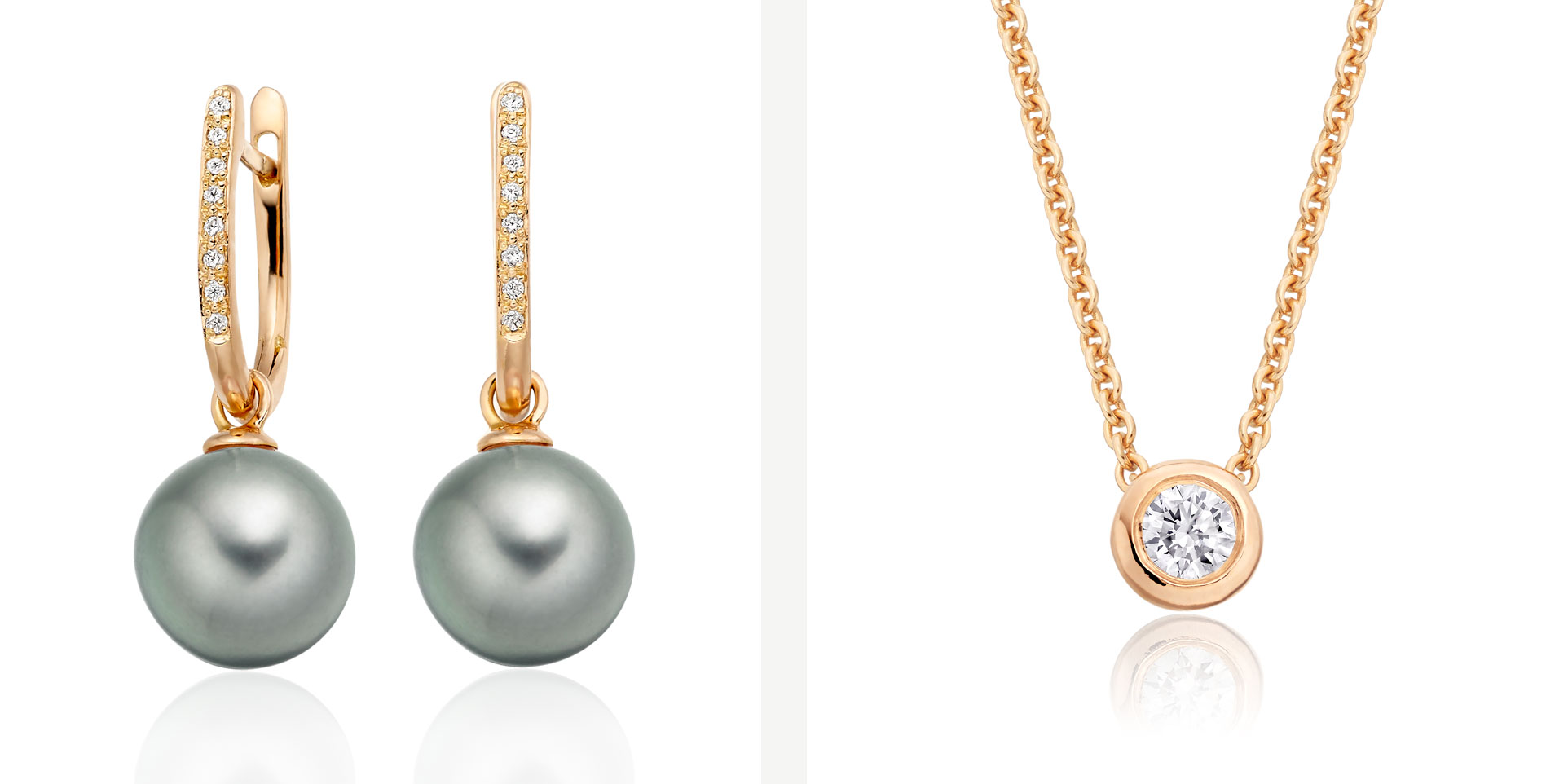
Image 1: Grey Tahitian Pearls with Diamond Leverback Earrings
Image 2: Classic 0.10ct Diamond Pendant
“When we get to the rose family,” says Leatrice Eiseman, the Pantone Institutes’ executive director, “we get ‘compassion, composure, warmth’, something that draws you in.”
One of the reasons for rose's popularity today is that, for consumer goods companies, this warmth has huge potential in attracting new customers. In growth markets such as China, the luxury connotations of gold and the “sense of mindfulness” that Eiseman identifies with its rose-hued cousin has significant appeal.
On trend for the autumn
In jewellery, Dior, Piaget and Van Cleef & Arpels have led the trend towards rose gold’s revival as a high jewellery material. Rose gold is a natural canvas for coloured stones, and brings delicacy as well as warmth to the traditional combination of white pearls with diamonds.
At Winterson, our Classics collection includes some of our most popular jewellery designs, that have been finished with 18 carat rose gold, white diamonds and pearls.
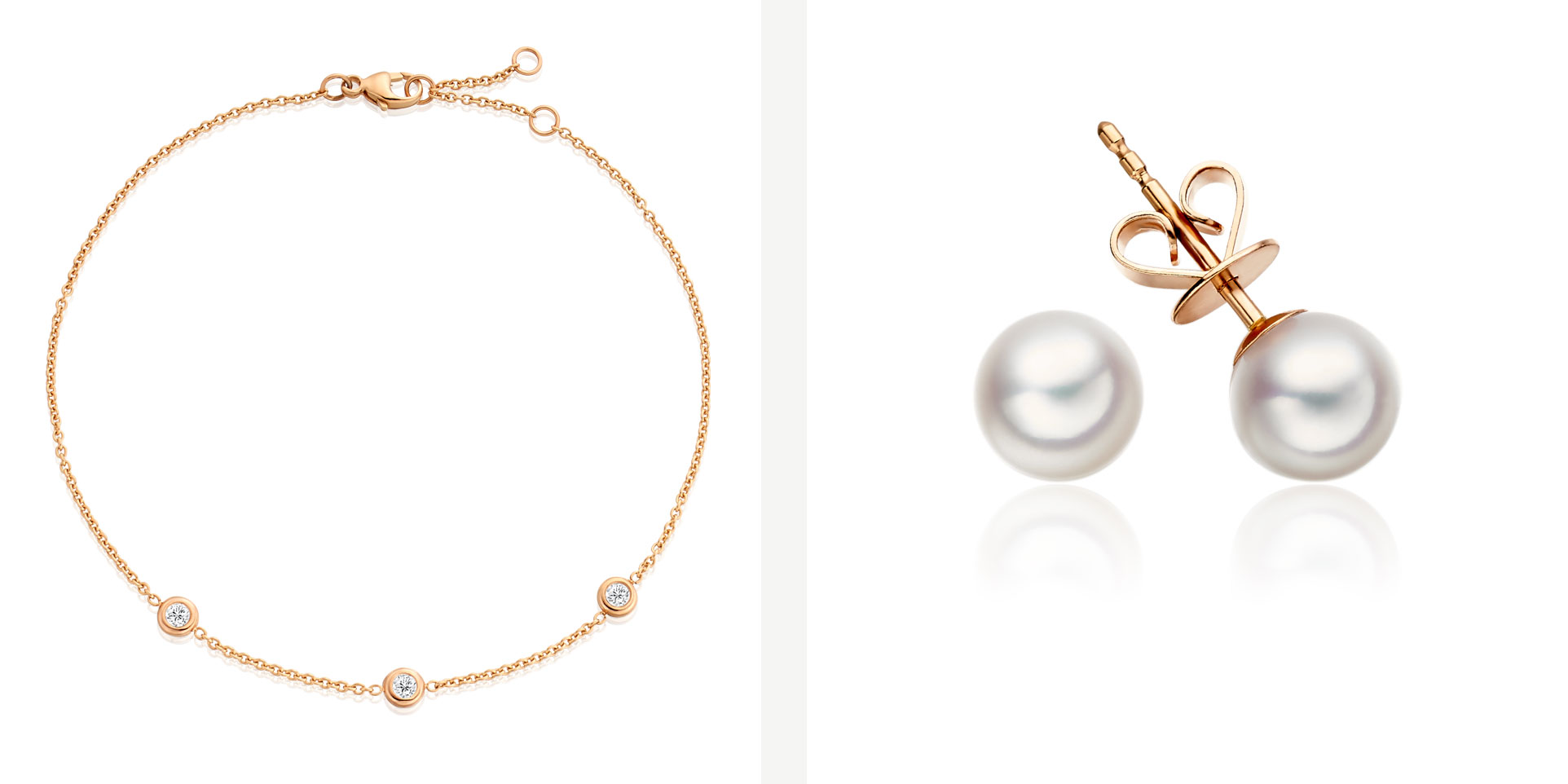
Image 1: Classic 0.12ct Diamond Bracelet
Image 2: Classic White Akoya Pearl Stud Earrings
There are many ways to wear this beautiful style of gold. We love the femininity of the rose gold and white diamonds of our new triple diamond bracelets and the elegant addition of light grey Tahitian pearls to our rose gold and diamond leverback earrings. The lovely combination of rose gold with the blush overtones of a white saltwater pearl in our Classic Akoya pearl studs might be the simplest and also the best.
Already a fan? Wholeheartedly embrace the trend with our striking Luna Moss ring in rose gold, green sapphire and a stunning peacock green Tahitian pearl. -
Interview with Melanie Georgacopoulos
Interview with Melanie Georgacopoulos
Melanie Georgacopoulos is renowned for her work reinventing the pearl for a younger 21st century audience. Today’s renewed fascination with the gemstone owes much to this young designer, a graduate from London’s famous Royal College of Art. The Winterson Journal talks to Melanie about her new avenue of exploration with the pearl.
Without inhibition, Melanie Georgacopoulos has sliced, drilled, quartered, caged and wrapped pearls in illusions of knots in her mission to bring this extraordinary gemstone to a new generation of jewellery buyers.
Her most recent collection, MOP Shell, directs her inventive energies to Mother of Pearl. Otherwise known as the material nacre, it is produced by mollusks as an inner shell layer as well as forming the outer coating of the pearls themselves.
What drew you to mother of pearl?
Natural Mother of Pearl has been used by many cultures all over the world, to create both expensive and inexpensive items. It is a strong, resilient and iridescent material that has been used for thousands of years, mainly in the form of inlay, which you see a lot in East Asian and Islamic religious art.
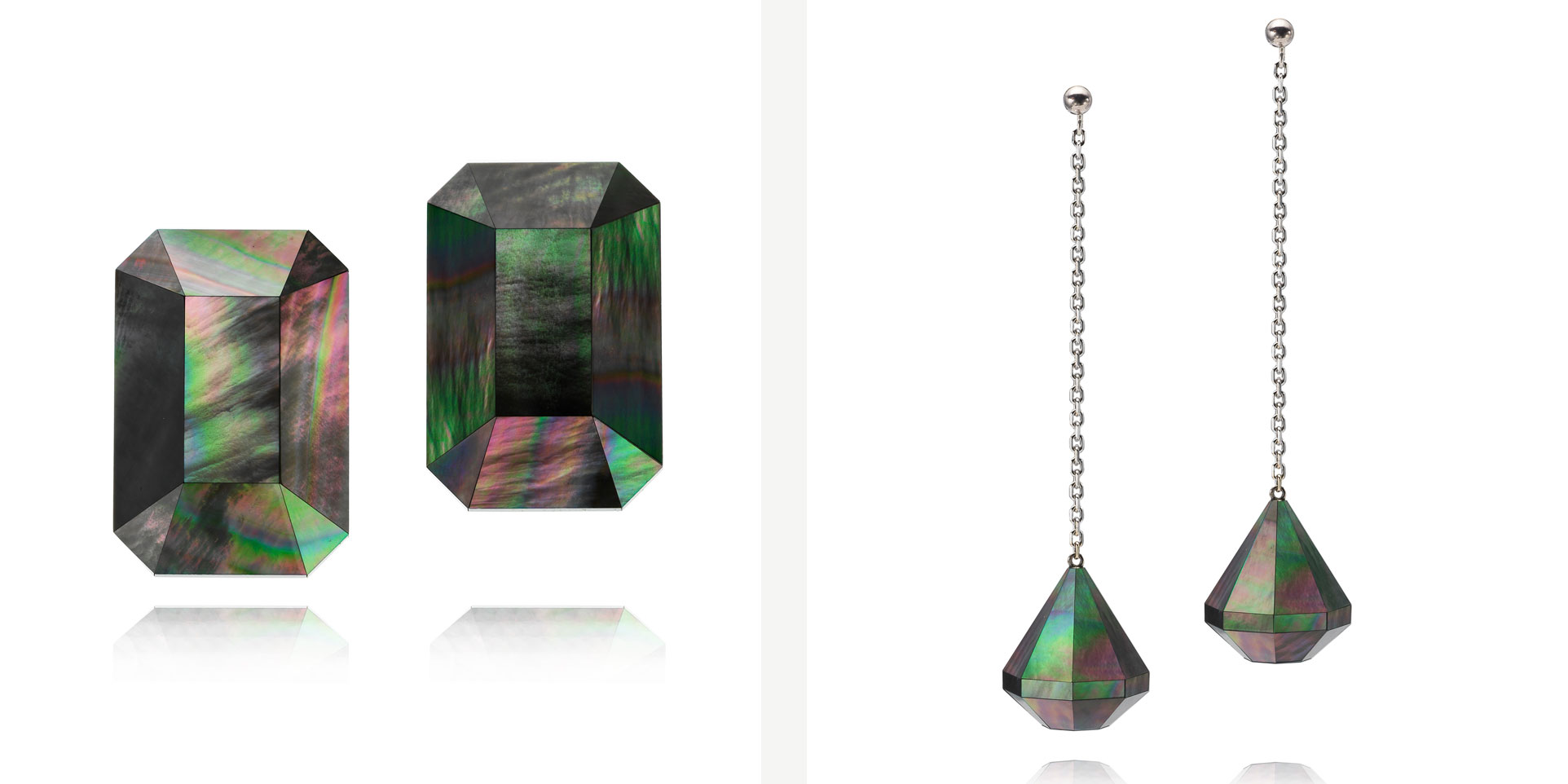
Image 1: MOP Emerald Earrings - Peacock
Image 2: MOP Diamond Dress Earrings - Peacock
At the same time, it was a popular material for more common Victorian household items such as knife handles and buttons, as well as Chinese gaming counters and delicate caviar spoons. I think it’s this heritage as a material that can move from high to low that originally sparked my interest.
You often look for the subversive angle in your design; what was the twist with mother of pearl?
As a material it is more widely used than pearls, but despite its popularity, it has never reached the pearl’s symbolic status. I felt that mother of pearl was ready for a reassessment, in the same way as the pearl felt for me back in 2007 when I first started to play with them in the studio at the RCA.
Pearls were so associated with the twin-set on one hand, and the ostentatious fakes of Coco Chanel on the other, that the gemstone felt like a really rich place to mine deeply for inspiration. Mother of pearl is in the same place really. One rarely sees it used in fine jewellery today and I wanted to explore whether it was possible to challenge those perceptions.
Your pearl collections tend to focus on the monochrome beauty of the gem, where MOP Shell really plays with the fabulous colours of the material. How did it feel to play more with colour?
The collection really aims to celebrate mother of pearl’s qualities as a material, and showcase its various beautiful, rich colors. It comes in soft pink, crème, white, peacock and golden yellow with many variations.

Image 1: MOP Emerald Ring - Multicolour
Image 2: MOP Emerald Earrings - Lavender
It was actually really refreshing to work with a flat material that has such striking colours and work out how to combine them. I’ve enjoyed this so much in fact, that my next collection focuses even more on these diverse colour combinations and how they change depending on the light.
You enjoy exploring the meaning of value in jewellery by playing with the forms of other classic precious gemstones – diamonds and emeralds – and that theme re-emerges here. Can you tell us a bit more about that?
When mother of pearl is used in jewellery, it's mainly seen flat and as an inlaid form. By taking this flat material and creating seamless three dimensional diamond and emerald shapes, I felt I could really push further my exploration into the relationship between gemstones and pearls in contemporary jewellery.
The pearl has moved on and off lists of precious stones over the centuries – from being the height of luxury and value in the time of Cleopatra to being close to worthless in the late 20th century due to overfarming. I think I have always been interested in playing with perceptions of value, asking questions in particular about the value of design and how people perceive that.
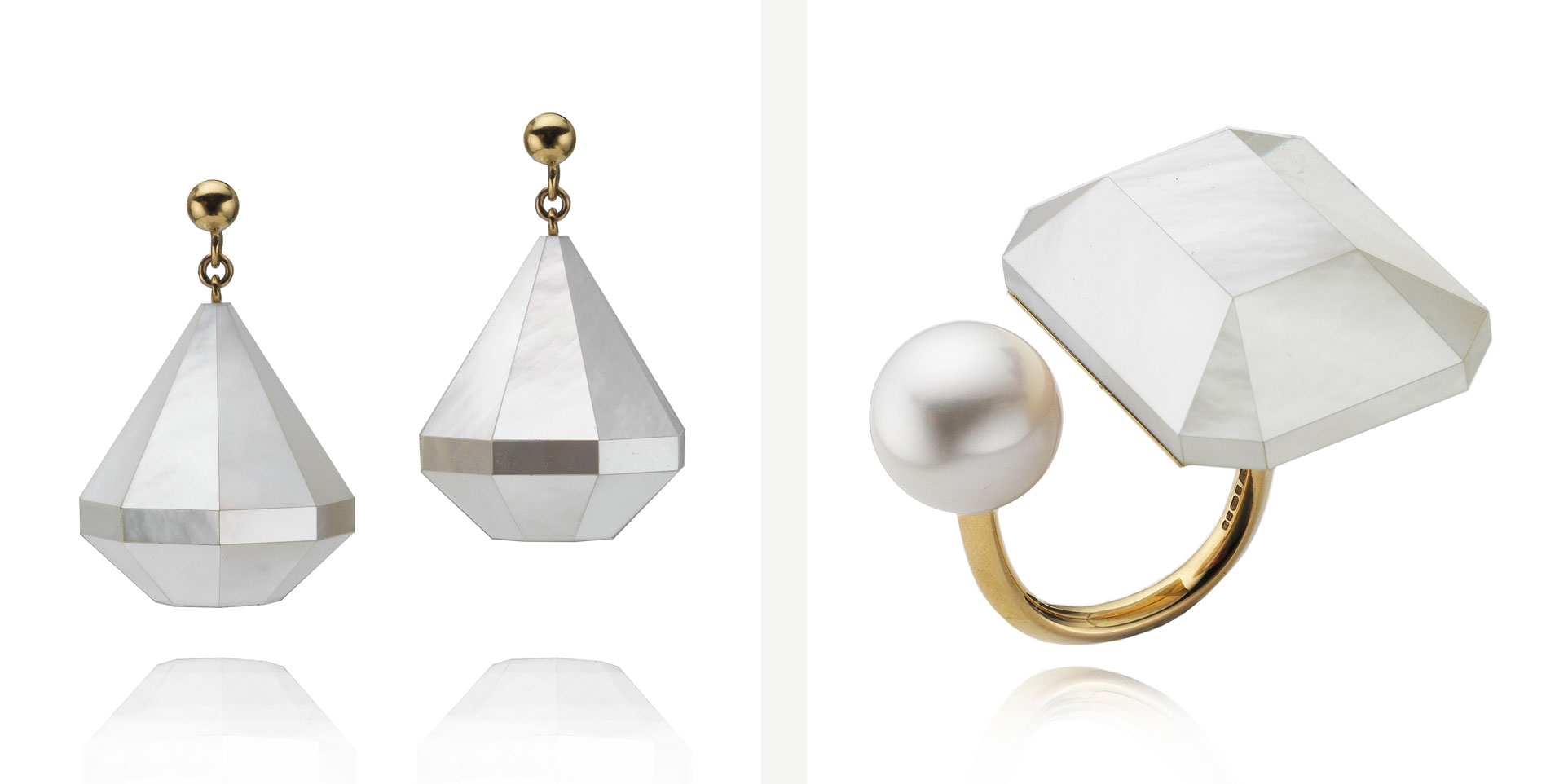
Image 1: MOP Emerald Ring - White
Image 2: MOP Emerald Earrings - White
These pieces are strikingly simple, made of relatively poorly perceived materials, and yet the high craftsmanship and labour intensive production that each piece requires elevates the material far beyond any financial worth one might place on the components.
What drew you to jewellery originally and what’s the Melanie Georgacopoulos design philosophy?
I first studied sculpture and my love of jewellery comes from the fact that it relates to the body. I’m also fascinated by the connection that people have to the jewellery they pass on one generation to another.
One of the reasons I think I may have been subliminally drawn to pearls is that my grandmother wore a pearl necklace every day, and that idea of creating something that is worthy of becoming so intimately connected with a person’s identity really interests me. Good design, for me, is innovation, longevity, and has to represent its time. I strive for this with every piece.
View more jewellery by Melanie Georgacopoulos here. -
Winterson Prize 2017: Meet The Designers Part II
Winterson Prize 2017: Meet The Designers Part II
Each year we work with the student jewellery designers at Central Saint Martins in London, giving them an opportunity to experience designing with pearls for their final year collections.
We will be awarding the Winterson Prize 2017 to one of the students for ‘The Best Use of Pearls’ at the CSM Jewellery Awards Evening on 22nd June.
The BA Jewellery graduate collections are exhibited at CSM and open to the public from June 21st - 25th.
Here we feature the final part in a series of short interviews with designers from the CSM Jewellery 2017 show, including in this article - Maria Mungsommai, Ruhong Chen, Xiaoyu (Coco) Guan, Xindi Nie, Yanmi Lui and Yingping Shen.
Read about the other designers in Part I of this series and the winner of this year's prize.
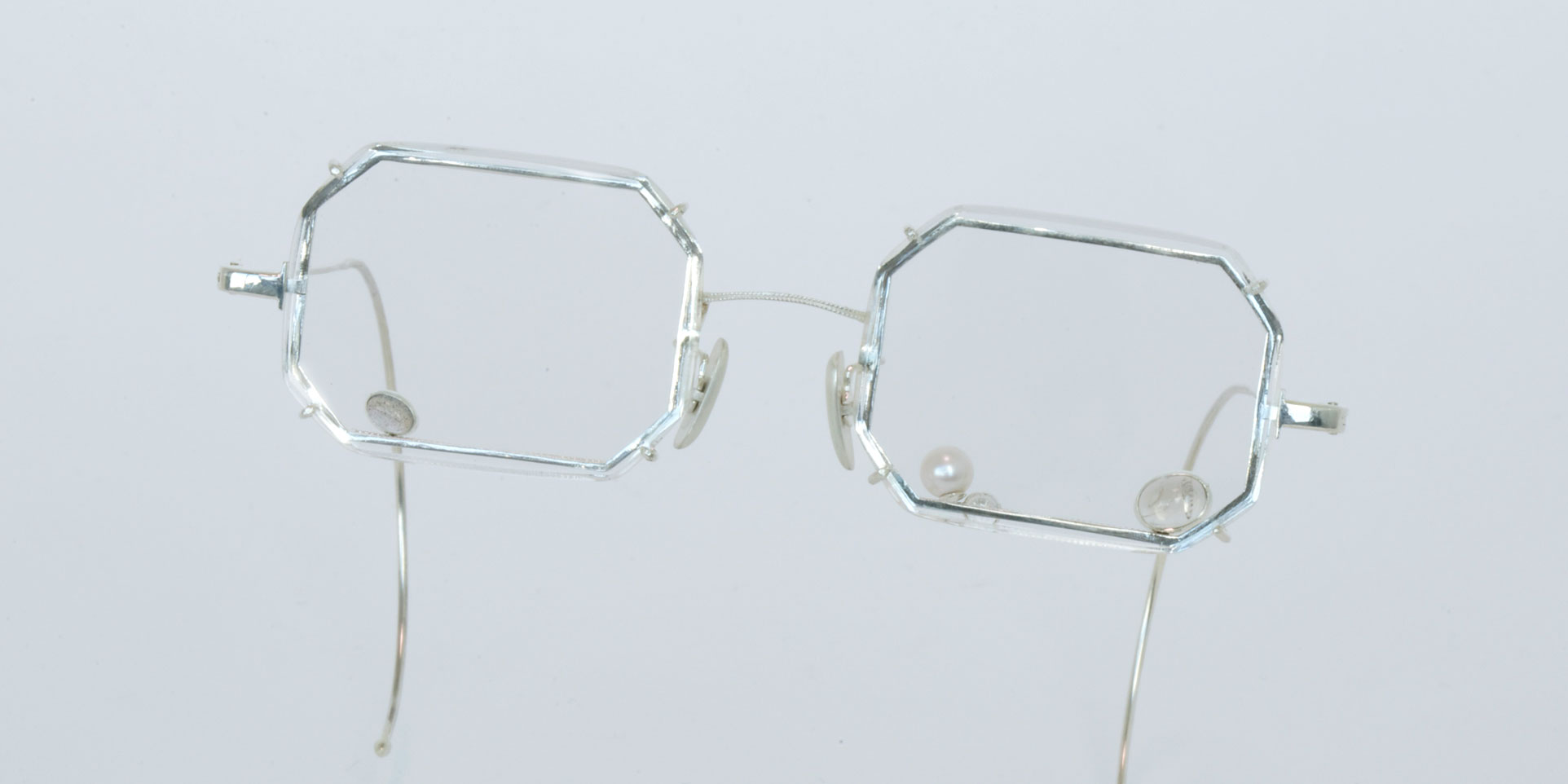
Maria Mungsommai
Tell us a little bit about yourself.
I'm from Thailand and I have lived in the UK for 7 years so far. I came from an academic background and London gifted me with the love for art. Growing up in two vibrant places, I have always been inspired by the eclecticism of both cities and the subject of psychology. Jewellery, for me, is very special. It's magical how such small objects can mean so much.
What was the inspiration for the 'Rose Glass' collection?
It started from a stroll down the jewellery bridge in Ponte Vecchio, watching people looking at fine jewellery window display and asking what is jewellery to them. When looking at fine jewellery such as an engagement ring, it's like there is an instant rose-tinted glass filter. Rose glass is about the romantic desire for fine jewellery. Seeing them and wanting them. Taking inspiration from window displays, for instance, the frame, the glass and the jewellery stand themselves, looking at how jewellery are presented. I wanted to create that romance of seeing jewellery placed behind a glass.
What do you find inspiring about pearls?
Pearls are really romantic in a sentimental way. For me pearls portray a true nuance of romance. Fragile, subtle, a beautiful imperfection. The lustre sort of resembles human skin as well. There's a softness to a pearl that can't be seen in other gemstones.
What have you discovered about working with pearls?
Every single one of them is unique. The dimples and colour differences in each one of them I find very beautiful. Handling them makes you feel instantly more elegant as well (hahaha).
Which designer or artist do you most admire?
There's so many! But if I have to choose I'd say I love the work of Louise Bourgeois and Raf Simons.
Who could you imagine wearing your jewellery?
Hmm.. I think they'll look good on Mia Goth.
What is it that makes a piece of jewellery a design classic?
Can I say whenever there's a pearl in the design? Haha. Well, I think a design is classic when there's some sense of subtlety in it.
What’s next for you after CSM?
I'm planning to do an MA in art business at Sotheby's.
Ruhong Chen
Tell us a little bit about yourself.
I have a passion in art & design and have known that I will work within these area since I was a child. In high school, I studied for two years an A-level in Product design, photography and fine art. Then I studied foundation in CSM and luckily got into BA jewellery. Last year I meet Jewellery Master Catherine Mannheim and studied with her for one month.
What was the inspiration for the 'Ornaments and Pearls' collection?
My collection was started by the idea of conveying a moment of pause and the peacefulness within. Inspired by Edmund de Waal’s project with the same title 'White' (2015- 2016), my research started by looking at the quality of the colour white. I perceive white as being silent, a very powerful quality. And that is why I make all my collection mostly in a silver white finish.
My design has been playing with second-hand ornaments for example; little toys, house decorative adornments, as well as something I personally owned. Ornaments I gathered from second hand market are sentimental objects, carrying the element of memories. By taking away the color, reworking from the form of those ornaments, I have been thinking how memories and white color can both deliever a new perspective to perceive the present world and what was in the past.
Inspired by the Maisie Broadhead art installation ‘pearls’, I like to use the forms of pearl strands in my design so that they appear to have airiness and movement. Initially the use of pearls wasn’t the main focus. However soon my first piece was made, which is a sleeping kitten playing with a pearl necklace. I think it conceptually challenges the traditional use of pearl jewellery. The pearl necklace in history, as seen in most classical paintings, often stands for decorum, hierarchy status and luxury. Here the pearls are being disrupted by the kitten’s sense of playfulness. The sense of subversiveness is strong, and so I adjusted my design direction to focus on the use of pearls, especially pearl strands. Considering how it can interact with the ornament, and how it brings out the preciousness of silver.
What do you find inspiring about pearls?
Unlike a diamond, which often dazzling and sharp, the beauty of pearls is more subtle, natural and refreshing. I am inspired by its varied luster and colour, especially as it appears like a rainbow, and the pearl’s different shapes are also fascinating. Using pearls with precious metal, it can really transform the metal, bringing a new liveliness.
What have you discovered about working with pearls?
I discovered that there are lots of ways to use pearls, It could simply be attached by gluing, or it can be applied by stone setting techniques, stringing, wiring, beading, crocheting and so on. More complex techniques to use pearls doesn’t make the work more valuable, the value come from how the use of pearl links to the context of the jewellery and how it makes a story as a whole. The visual quality of purity from pearls is also my focus when I work with pearls.
Which designer or artist do you most admire?
For jewellery design, I admire Otto Kunzli with his minimalism and the use of a witty metaphor in his jewellery, for example the work ‘Gold makes you blind bracelet‘. The gold is concealed in black rubber, the shape forming a gold diamond ring that most people would have.
In fine art area, I like Henri Matisse for his art of strongly expressive human body forms, for example ‘the dance’, as well as his paper cut works that are energetic, and have a curiosity for wondering.
Who could you imagine wearing your jewellery?
Middle aged women who have studied or work in fashion or an art associated area. Having a sense of humor, passionate about life, appreciates the beauty of simplicity and enjoys wearing pearls.
What is it that makes a piece of jewellery a design classic?
Knowing the aim of the jewellery, to be open and true to it throughout the design. Inspiration is important but there are lots of refinements needed. A design classic jewellery arising from new ideas should have a personality like people, which gives an intimacy between the wearer and itself. Continuing traditional techniques and to innovate are also important.
What’s next for you after CSM?
Study a Master degree jewellery in the UK, also start up my own jewellery business.
View more of Ruhong's work here.
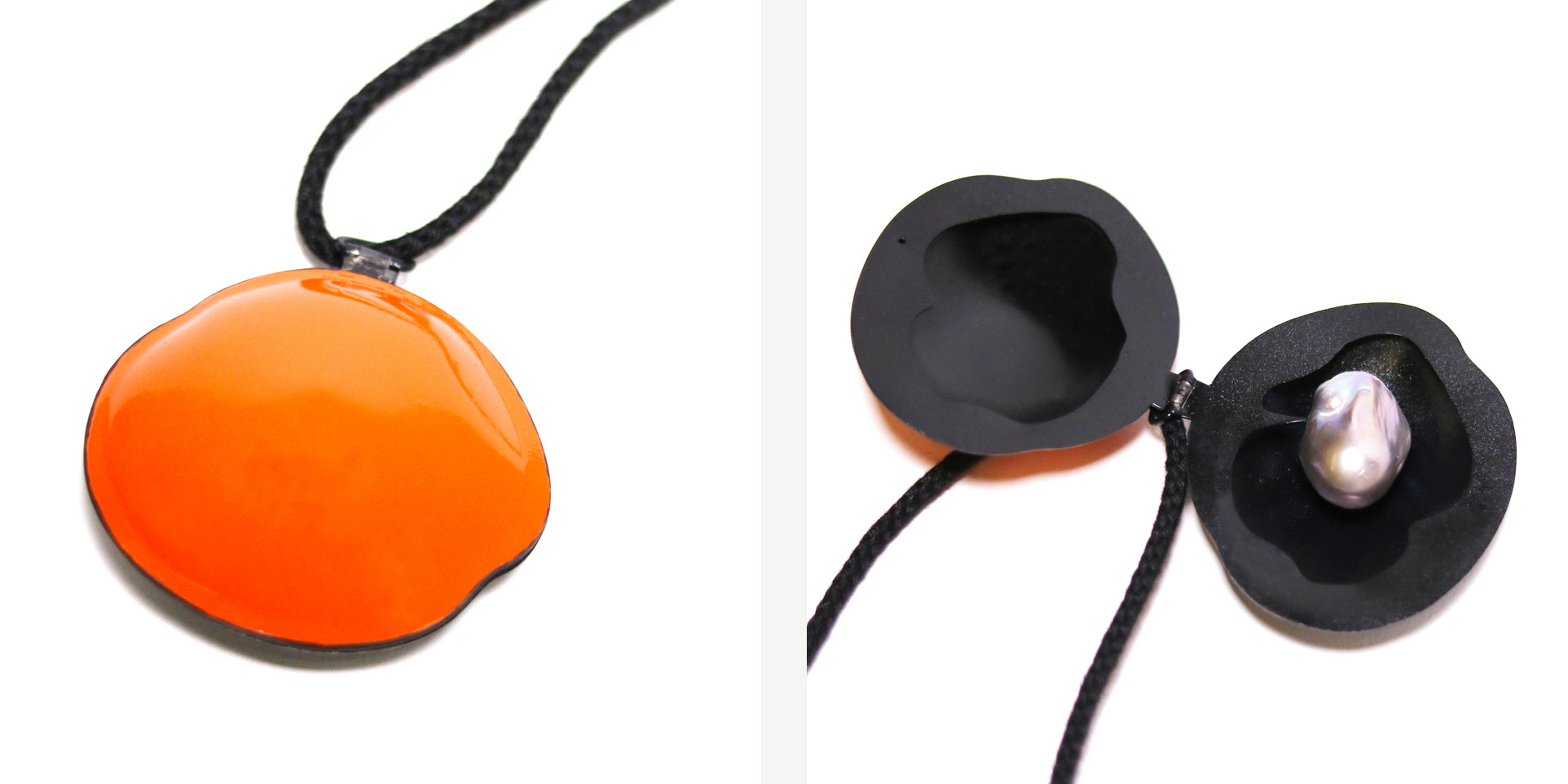
Xiaoyu (Coco) Guan
Tell us a little bit about yourself.
My name’s Coco. I’m a Chinese girl, staying in London for four years since my foundation course. I learnt Graphic & Communication Design three years in another University in China before, and then I came to CSM to study Jewellery design, which is my favourite major.
What was the inspiration for the 'Beans & Pods' collection?
The theme of this project is about beans and pods. Beans have long been interesting to me as a form and as a metaphor for positive, value, nourishment and potential. I’ve also been intrigued by how many different scales, shapes, textures and colors they come in. Due to the fact that we often eat beans in our daily life, I collected some different types of beans, such as mung beans, red beans and pea, thus, I want to use beans as a project starting point.
What do you find inspiring about pearls?
I’m interested in the shape of pearls. The surface of the pearl could be smooth and free of marks while the overall shape could be round, oval, pear-shaped, or even misshapen. For this project, I chose to use freshwater pearls, because I like the natural shapes. I feel they’re really like the real beans in the natural.
What have you discovered about working with pearls?
I feel quite good when I worked with them. It’s interesting to stitch pearls to metal.
Which designer or artist do you most admire?
My favorite jewellery designer is Peter Chang, who produces mainly jewellery in the form of bangles/bracelets and brooches. He uses a variety of methods to achieve the bright colors and bizarre shapes. The colors red and yellow were especially popular, and form a color combination often seen in Chang's work.
From his work, I started to understand and explore how colors work together, the responses color provokes in a viewer, and what color symbolizes in nature. For instance, for this project, I made my own color palette and started to overlay many layers of colors on the bean’s surface, meanwhile, I still keep the single color for some of them.
Who could you imagine wearing your jewellery?
I think most of female will love my woks, because of the colors. For the whole collections, I used a lot of bright color, as the aim was to bring people limitless happiness when they try or see my works. And it’s also the main meaning of my works. I hope people can feel happy and get lucky when they wear them.
What is it that makes a piece of jewellery a design classic?
I think it’s the meaning and story behind that piece. The appearance of a jewellery, the color, or the shape should be attractive for people to stop by, but when you understand the story behind it or what it really means, you will appreciate it forever.
What’s next for you after CSM?
I already got a MA Jewellery design offer from CSM. Therefore, I’ll still stay London to finish the course and learn more things.

Xindi Nie
Tell us a little bit about yourself.
I’m 22 years old and interested in installation art pieces.
What was the inspiration for the 'Incidental Poetry' collection?
The integration of irrelevant objects fascinates me greatly with the sense of surrealism that is created by the process of clashing and combining. Such events occur accidentally all the time in our day to day lives, objects being turned into another form of existence which also serves an entirely different purpose.
On the other hand, does jewellery possess an ability to influence or even entirely replace the being of ordinary objects in a traditional manner?
What do you find inspiring about pearls?
Pearls are my favorite material, they are unique among other jewellery materials, such as metals and stones, as they are relatively softer and contains gentle sheen. Pearls play a essential role in my collection.
What have you discovered about working with pearls?
The techniques of using pearls is a different category compared with other jewellery techniques that I learned before. I was very impressed with the way of stringing pearls, and french wire finishing techniques.
Which designer or artist do you most admire?
Artist: Giorgio Morandi, Roni Horn, Lois Weinberger, Mark Manders
Designers: Reka Lorincz, Marc Monzo, Bernhard Schobinger, Hands Stofer
Who could you imagine wearing your jewellery?
I would like to think of my works as art pieces, which is a homage for Giorgio Morandi. His paintings inspired me a lot.
What is it that makes a piece of jewellery a design classic?
The concept behind the design makes a piece of jewellery meaningful and classic.
What’s next for you after CSM?
I’m applying for an MA course at this moment.
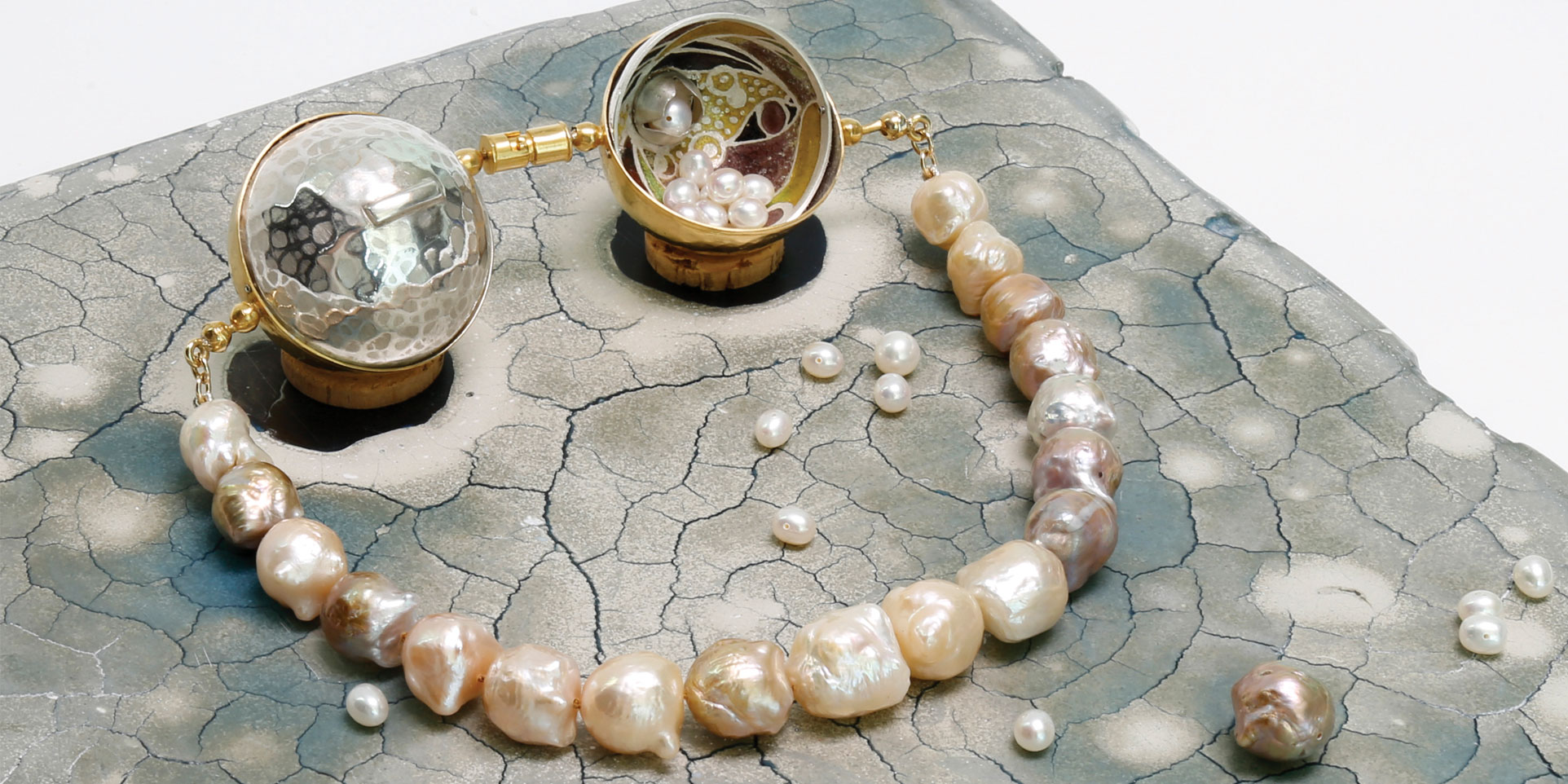
Yanmi Lui
Tell us a little bit about yourself.
I am always curious about things and I let my mind wander when I’m travelling.
What was the inspiration for the 'Modern Self-defence Armour & Weaponry' collection?
Initially, I am inspired by the culture of different types of martial arts that do and do not use weapons in self-defence, because this form of fighting is integral to many security-related professions e.g. hostess, guards, military training. I enjoyed researching the developmental process of creating a weapon and analysing its changing values in the progress of a modernizing society.
Secondly, Biomimicry: I find the natural design systems in organisms fascinating, especially at a very small scale in insect defence mechanisms.
What do you find inspiring about pearls?
Most defence mechanisms have sharp, warning shapes and textures. I chose to use the iridescent and ‘soft’ qualities of pearls as embellishments to counteract with ‘aggressive’ forms. The way that pearls are formed is a type of natural defence mechanism – molluscs use layers of iridescent nacre to wrap around the intruder, forming a pearl.
What have you discovered about working with pearls?
They are very versatile to work with.
Which designer or artist do you most admire?
Jackson Pollock (Abstract Artist)
Who could you imagine wearing your jewellery?
‘Cheeky’, playful people who like hidden surprises.
What is it that makes a piece of jewellery a design classic?
Memorable, stand-out elements in a piece of jewellery; something that is understood by a big audience. A technique that is shared and practiced by many people i.e. a class strand of pearl necklace is made from specific string knotting techniques.
What’s next for you after CSM?
Work to learn more about the industry hands-on, or if because of visa limitations, I am deciding to learn more about functioning systems on a Masters level.
View more of Yanmi's work here.
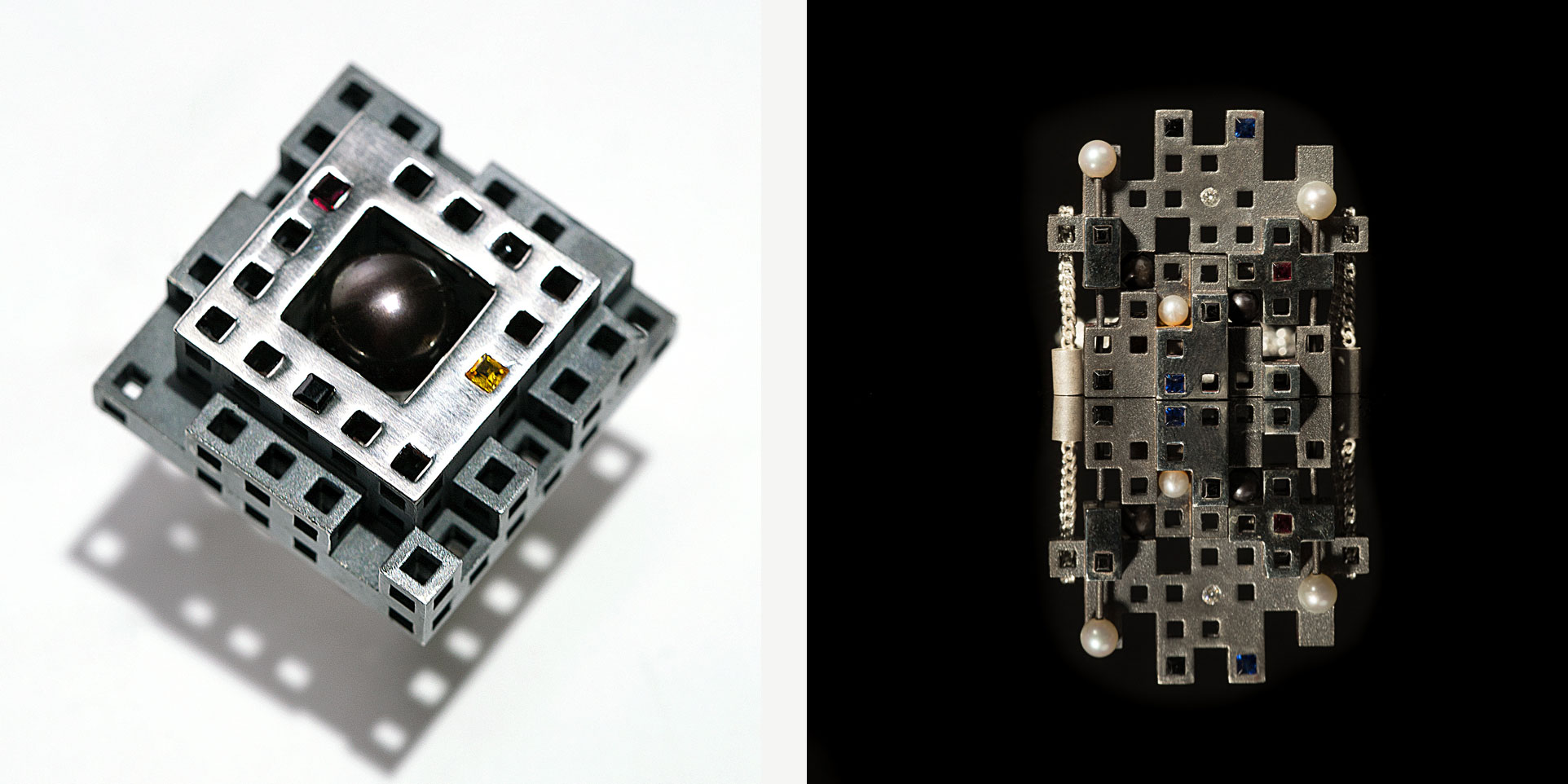
Yingping Shen
Tell us a little bit about yourself.
I am from China, I studied jewellery identification in China.
I like to combine other design elements into my jewellery, such as fashion and architecture. I think I don’t want to be an artist, I want to be a good jewellery designer in the future, making jewellery between fine and contemporary.
What was the inspiration for the 'Breathing' collection?
I was inspired by the cityscape. I saw the busy buildings in the city, and endlessly windows on the buildings, so many people working inside day by day. I wanted to express a fervent desire to escape from the city’s asphyxiating environment. I used different colours (black and white), different shapes, and some moving parts on the jewellery to express people's need to breathe. Pearls and precious stones express the people (precious) in the buildings.
What do you find inspiring about pearls?
This is my first time that I have used pearls in my jewellery.
I think jewellery with a pearl, and without a pearl are very different, with a pearl that can make a jewellery more feminine.
I think it is very good for my collection, because my collection is based on so many cubes and straight lines, it looks very masculine, but the use of round pearls can change this.
What have you discovered about working with pearls?
I bought some half drill pearls to work, and when I put pearls into the pins, around the holes, the pearls are very easy to break.
Which designer or artist do you most admire?
I like Renzo Piano, the architecture designer.
Who could you imagine wearing your jewellery?
I want to make some jewellery for everyone, unisex, and all ages.
What is it that makes a piece of jewellery a design classic?
I think contemporary jewellery needs a very good story or idea. And fine jewelry needs a good design and good material.
What’s next for you after CSM?
Find a job and make my own brand. -
Winterson Prize 2017: Meet The Designers Part I
Winterson Prize 2017: Meet The Designers Part I
Each year we work with the student jewellery designers at Central Saint Martins in London, giving them an opportunity to experience designing with pearls for their final year collections.
We will be awarding the Winterson Prize 2017 to one of the students for ‘The Best Use of Pearls’ at the CSM Jewellery Awards Evening on 22nd June.
The BA Jewellery graduate collections are exhibited at CSM and open to the public from June 21st - 25th.
Here we feature the first part in a series of short interviews with designers from the CSM Jewellery 2017 show, including in this article - Annie Kim, Biwa Pik Wa Wong, Ely Cao, Georgina Hopkin, Holly O'Hanlon and Jieun Kim.
Read about the other designers in Part II of this series and the winner of this year's prize.
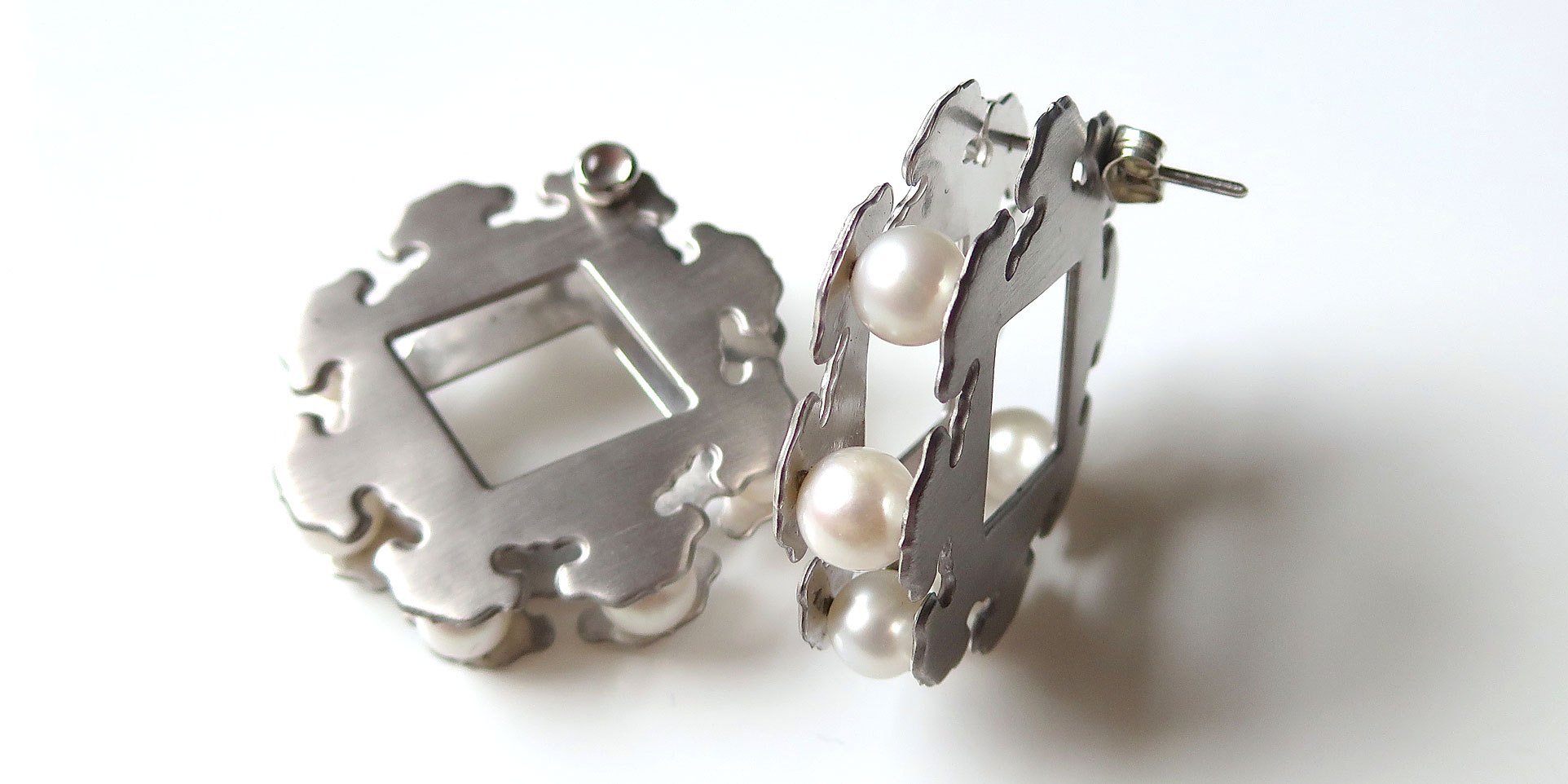
Annie Kim
Tell us a little bit about yourself.
My name is Annie and I was originally born in Korea, then at the age of 13, I decided to study abroad in Manila, Philippines by myself to learn English. As I always had my passion towards Arts, I moved to London for high school and aimed to apply for Central Saint Martins where I could open my vision towards Jewellery Design. I did my foundation course in CSM and continued my study for BA jewellery design at the same college.
What was the inspiration for the 'Re:Heritage' collection?
This collection encapsulates my personal awareness of Korean heritage, focusing on traditional patterns drawn from architectural structures and details of temple facades.
As a Korean person, who left my home country at an early age, I want to reconnect with my cultural roots and so I chose to work with details of my heritage as inspiration for my BA jewellery collection.
In my design research I focus on the graphic surface patterns and motifs found on ceramic tiles and also wooden panels in temples. I believe these to be culturally meaningful and too important to be forgotten and seen as “old” or “passé”. They represent Korean heritage, and so carry both visual and cultural value.
Inspired by the architectural constructions of the temples, each earring design is layered and at times articulated, in its construction. I was amazed how each space is filled out with such a fine detail, while also considering very much vivid colours.
What do you find inspiring about pearls?
It is the first time I have used pearls within my work and I think this material has a strength and a characteristic representing elegance and purity. The colour on the surface not only has one dominant colour, it glows and shines in different angles. I was inspired by how adding a single pearl with my pieces changes the mood. Not only did it turn my piece from 2 dimensional to 3 dimensional, it allowed me to add another texture and colour that matches well with any kind of metal or precious stones.
What have you discovered about working with pearls?
I have discovered that pearls do have wider possibilities of transforming, while they are also very fragile. For one of my pieces, I had to enlarge a hole size, up to 2mm with a 7mm pearl size, which was a big pressure given to the pearls. However, the pearls were stronger than I believed and also had so many different ways of connecting them together involving other materials. The simplest way of keeping up the pearls was able to show their best purity.
Which designer or artist do you most admire?
Throughout my researching of artists, I have admired the work of Susan Collis. She uses mother of pearl as one of her materials and I was intrigued by the way she displays the material with daily marks on natural objects. It was a simple display that showed the characteristics of the mother of pearl that matched really well with our everyday objects.
Who could you imagine wearing your jewellery?
Not only this collection does this endorse Koreans, I wish to encourage others to wear it also. My main theme and inspiration comes from Korean heritage, however, I wanted to create a collection that others can easily adopt while wishing them to be attracted to wear my jewellery as well. Allowing them to get comfortable with my country’s craftsmanship was the aim and the invitation.
What is it that makes a piece of jewellery a design classic?
I believe speaking out and directly showing what your inspiration is; in your design the main key is to be classic. Once a designer has a theme or meaning, I think it is important they show that straightforward towards the shape or pattern of the piece. Pieces that includes more meaning and asks the audience to think through might appeal more personal awareness of that particular designer.
Also, I think using materials that are commonly known to be classic or simple/pure should take up a big role. Textures and colours are also important while designing.
What’s next for you after CSM?
I wish to learn wider skills and understanding in jewellery world. I think there is so much more I need to discover and learn from designers and artists who are much experienced than me and that one day I will get a chance for me in future to teach others about jewellery and arts.

Biwa Pik Wa Wong
Tell us a little bit about yourself.
I am from Hong Kong, China. I like making things that really reflect myself and relate to myself. Combining traditional and comtemporary ideas together, to consider design conceptally and visually.
What was the inspiration for the 'Made of China' collection?
The title of my collection is ‘Made of China’ as I am using China,the porcelain mostly in this collection.
Porcelain may typically be associated with chinaware, but my Made of China, hopes to break that stereotype. By transforming the material into wearable ornaments, I introduce it as a versatile substance that can be utilised beyond its original purpose and reflects my heritage.
Combining traditional and contemporary techniques, the pieces are crafted from traditional porcelain beads embellished with handwritten texts, high-strength ceramic beads adorned with lithographic decals, and 3D-printed ceramics.
The result is a sleek and minimalistic set of grandes complications personifying Chinese philosopher Zhuangzi’s idea of damei or “great beauty,” the concept of understated elegance that originally inspired the collection. Truly embodying the “less is more” maxim, Made of China is a delicately refreshing alternative to today’s tendency towards excess.
What do you find inspiring about pearls?
As I am using porcelains, challenging the techniques of making porcelains balls,I found a technique in a ceramic company in Jingdezhen which is a ceramic town in China which specialized in making porcelains ball with a pearl finish. The balls are as glittering and translucent as the pearls,so I used real pearls with my porcelain balls design to enhance its luxury.
What have you discovered about working with pearls?
Whilst I have been working with pearls, I discovered that pearls are really easy to work with but also hard to work with. A single pearl is a piece of jewellery that has its own different colour, shape and gloss. Designing with pearls is not easy - how to bring the most out of a pearl and not going too far is what I should consider when I am working with pearls.
Which designer or artist do you most admire?
Dutch painter Johannes Vermeer.
Who could you imagine wearing your jewellery?
A girl with real class.
What is it that makes a piece of jewellery a design classic?
Simple, but heart catching.
What’s next for you after CSM?
Being a jewellery designer.
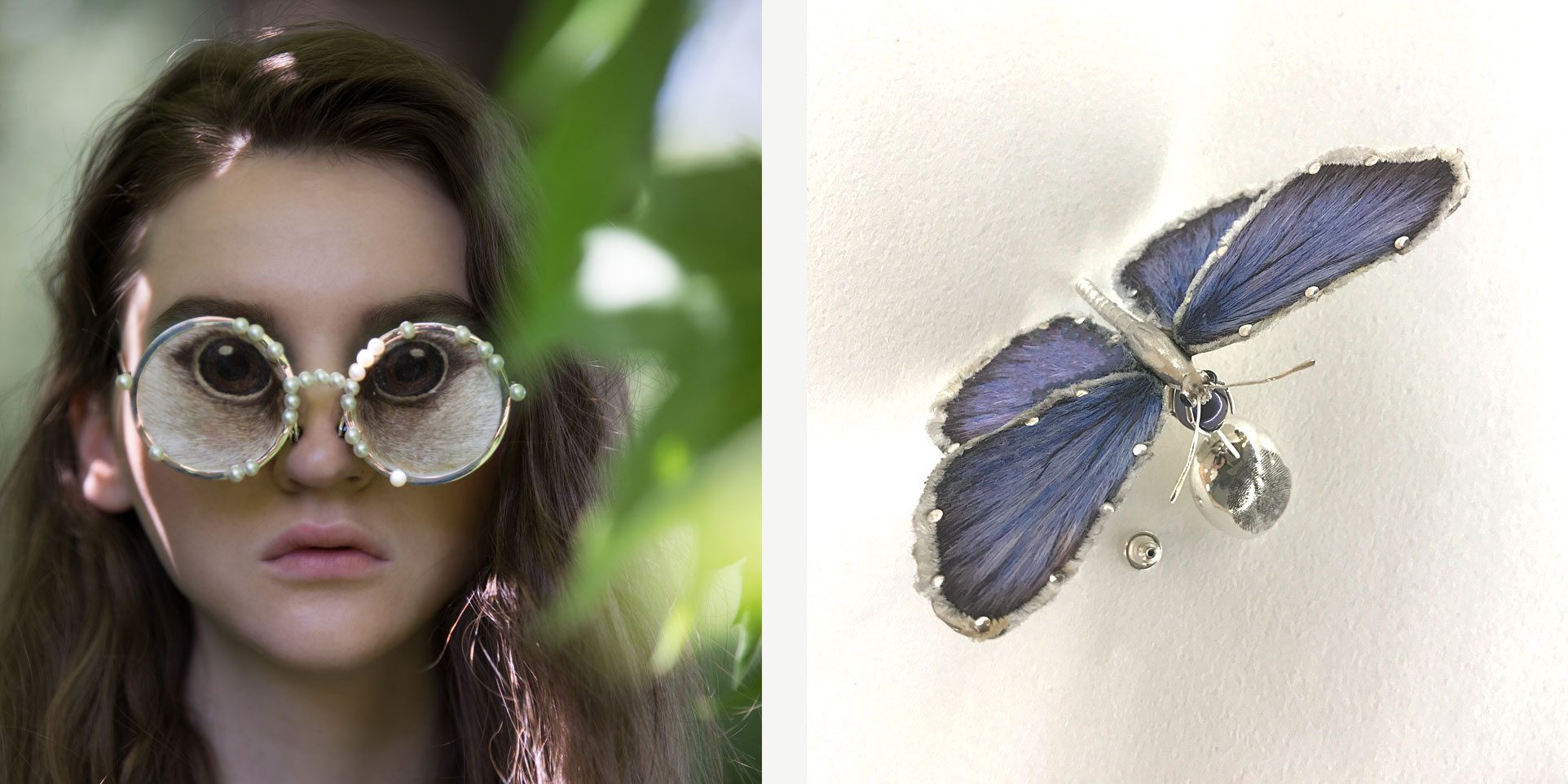
Ely Yili Cao
Tell us a little bit about yourself.
Trained to be an architect, changed mind before my BA to work with smaller scale 3D pieces.
What was the inspiration for this 'Silk Menagerie' collection?
My belief, my cultural background and my aesthetics, as a jeweler, an embroider, an animal-lover and a Chinese.
What do you find inspiring about pearls?
Their unique aura, which is not provocative yet stands for itself.
What have you discovered about working with pearls?
It is a fragile but strong material. With the right amount, colour and shape, it lights up the whole piece.
Which designer or artist do you most admire?
Tadao Ando and Christopher Lemaire, they work in different fields but share a unique sense of satiety, a balance between material (materials if necessary) and empty space.
Who could you imagine wearing your jewellery?
Personally, I don’t wear jewellery as I don’t wanna label myself as a certain type of jeweller, similarly I don’t label my jewellery to certain group of wearers. I will leave the choice to wearers and my pieces.
What is it that makes a piece of jewellery a design classic?
A sense of satiety. Every details tells the same story, yet represents its own reason of existence. The existence and emptiness create harmony.
What’s next for you after CSM?
I was offered two places - one in RCA Jewellery Metal and another in RCA Fashion millinery. I chose millinery to challenge myself as a more versatile designer.
View more of Ely's work here.
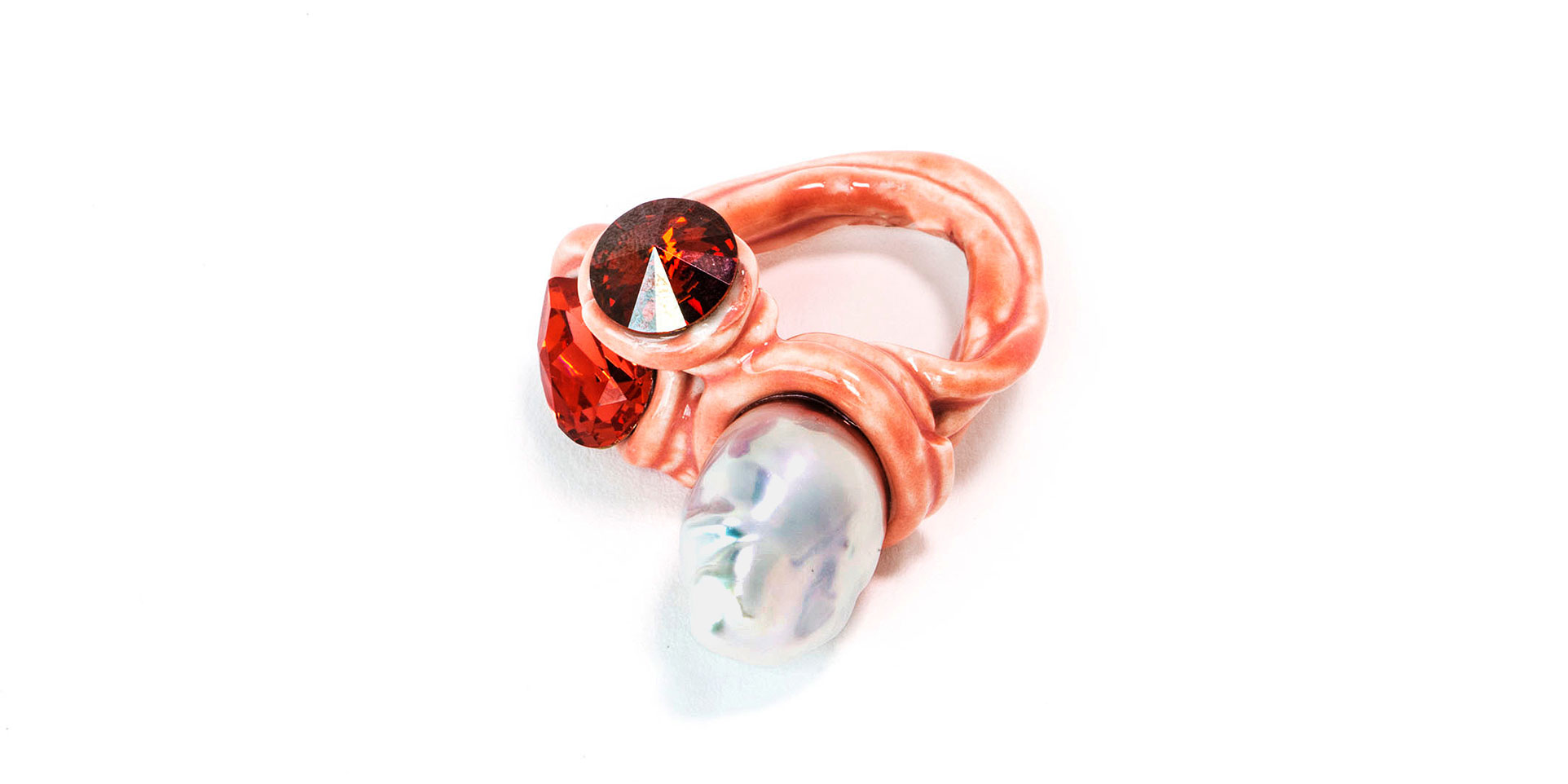
Georgina Hopkin
Tell us a little bit about yourself
I am a British jewellery designer and maker. I only create things that excite me and evoke a reaction from people.
What was the inspiration for the 'Organ Cake' collection?
I want to push peoples perception of jewellery, and also investigate the fine line between the grotesque and the sublime. I was inspired by artwork made of intestines and meat, which were presented in a way that didn't make them appear gruesome. I found it interesting how people only have a repulsed reaction once they realise what they're looking at.
What do you find inspiring about pearls?
I love the imperfect shapes that pearls come in. They also acted as a nice counterbalance for my grotesque foam and ceramic pieces. I found it funny to add pearls (a symbol of luxury) onto oozing organ-like objects.
What have you discovered about working with pearls?
It isn’t often that I work with precious stones or materials, so it was a new experience for me. I learnt how delicate they are and how to correctly string them, a technique which I was able to alter to suit my designs.
Which designer or artist do you most admire?
Karl Frisch. His jewellery helped me open my mind to ‘ugly’ settings, and seeing the beauty in the unconventional. Also Grayson Perry has inspired me to just be myself.
Who could you imagine wearing your jewellery?
Someone who likes pink and has a sense of humour.
What is it that makes a piece of jewellery a design classic?
Something that stands out against current design, and it might help if a famous person wears it.
What’s next for you after CSM?
I am an open book right now, I can live and work anywhere. I would like to work in the city, or any city, but also live in the countryside.
View more of Georgina's work here.
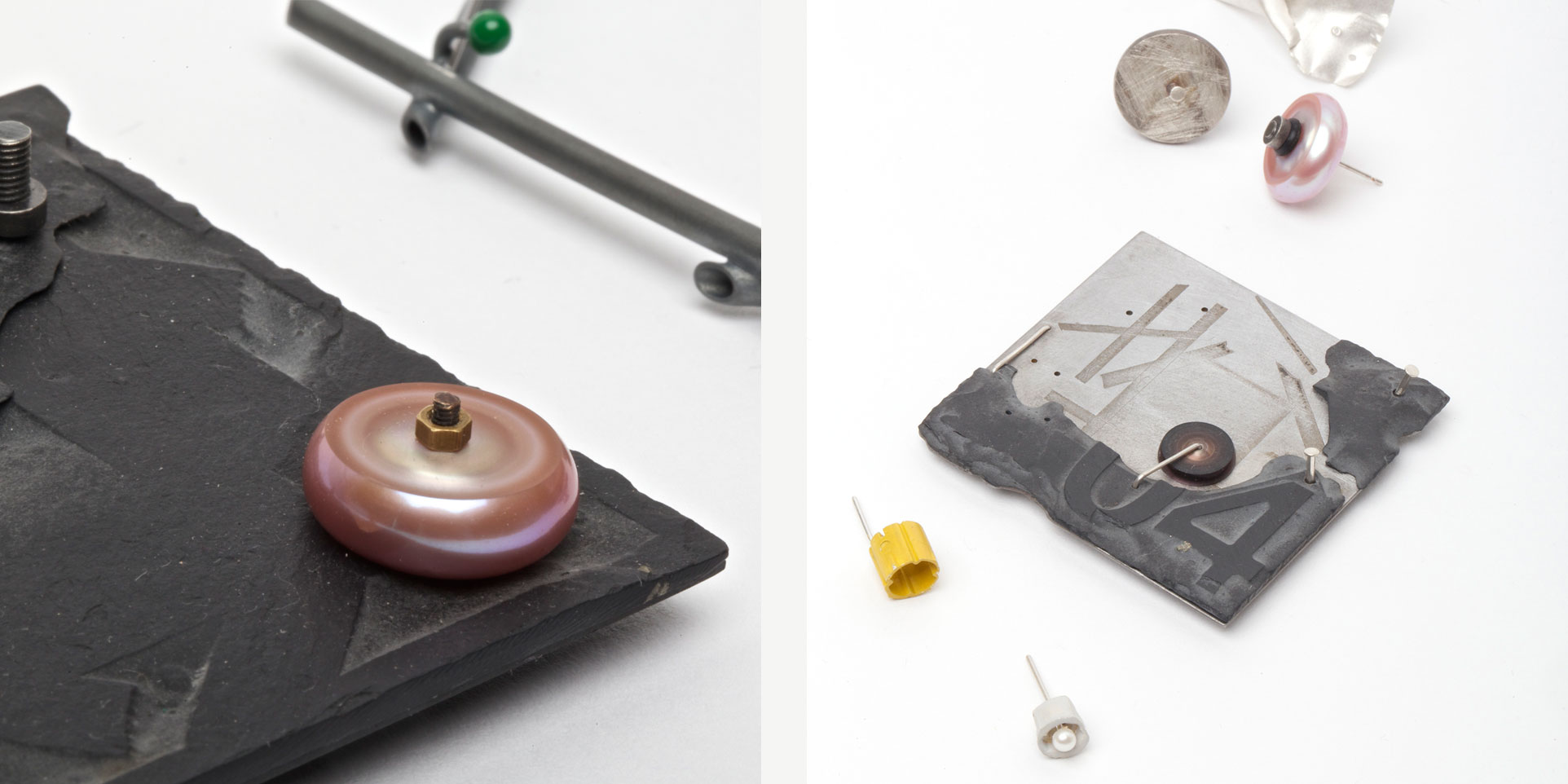
Holly O'Hanlon
Tell us a little bit about yourself.
My name is Holly O’Hanlon and I’m from Galway, Ireland. I’ve been studying BA Jewellery Design in Central St. Martins for the past three years. The way in which people interact with everyday objects, the associations and feelings the familiar can evoke is central to my work. My priority is to draw attention to the overlooked, utilitarian or mundane and, in particular, to the traces and fragments that remain from a practical task.
What was the inspiration for the 'Excess' collection?
My starting point for the collection was exploring different forms of excess. Through using slate as my primary material I aimed to emulate surfaces of walls and signage that change through corrosion or human contact and intervention. In doing this I hoped to show how the absence of an object can be communicated through its former location and the material that previously surrounded it- framing the unseen. The fragility of the slate juxtaposed with the lustrous quality of the pearls really highlighted the versatility of the two natural materials - precious merging with non- precious which executed the concept well.
What do you find inspiring about pearls?
Pearls have such an inherent preciousness that only increases once you begin to work with them. They have such a rich history and I find it interesting to subvert this to a level of utility for example, pearl washers attached to brooches using a silver staple or screw and earring backs that support individually crafted and enamelled silver thumbtacks.
What have you discovered about working with pearls?
To execute my designs , I used a process where I ground each pearl down to emulate the form of a washer- flattening both sides and keeping the finish of the rounded edges intact , the different layers of concentric colours and tones that were revealed were so beautiful and exciting and really added a new dimension to the pearls that previously remained hidden and unseen.
Which designer or artist do you most admire?
Naomi Filmer, the dialogue and balance she creates between her jewellery and the body is so sensitive and equally impactful. She is such a jewellery hybrid and her innovative approach to contemporary jewellery by visualising negative space through her knowledge of materials and processes is something I found really inspiring this year.
Who could you imagine wearing your jewellery?
As my pieces are unisex, I would hope they will appeal to anyone with an appreciation for detail, contrasting surfaces and materials within jewellery which applies a deceptive and playful approach!
What is it that makes a piece of jewellery a design classic?
A piece that utilises an innovative use of craft with a skilled application of techniques in combination with a considered design capability that has a sense of wearability.
What’s next for you after CSM?
As of now, my aim is to continue to develop and improve my knowledge and skills within industry in order to learn from people more experienced than myself. However, I am an open door to any opportunity that would still enable me to do what I love - jewellery!

Jieun Kim
Tell us a little bit about yourself.
I am from South Korea where I studied oriental painting before starting the jewellery course here at CSM. Tradition comes quite naturally as an approach to my work as I enjoy applying skills specific to metal in my work. Nevertheless I state that I am a contemporary jewellery designer using tradition with a twist.
What was the inspiration for the 'Crowning Moment' collection?
This collection goes along the lines of the work by renowned artist Jeff Koons, in the sense that I am using visual trickery and challenging what is expected of a material. I transform metal into fluid shapes. Each piece from the collection represents a different stage of the tying and untying of a bow knot – a gesture that I have enjoyed decomposing to reveal the simple beauty in movement, the celebration of a moment.
What do you find inspiring about pearls?
My designs tend to develop into simple forms that have boiled down my idea to its essence. Pearls represent the simplicity and purity of form that I try to reach in each of my projects. The subtlety in colour, the strength in quality and yet pale and fragile appearance of a pearl seem adequate with any kind of material. It is more of a universal than neutral quality that can be associated with it. In my eyes, pearls against fabric bring forward to extremes of smothers, creating an intriguing contrast. This is why I have integrated a pearl into my centre piece.
What have you discovered about working with pearls?
With the round pearl I used specifically for my collection, I learnt ways of setting in a measured gap.
Which designer or artist do you most admire?
Alexander McQueen has been a great inspiration. He has managed to create his own world with all its intricacies at the top of the immense fashion industry. His pieces are expressive and tailored to perfection.
Who could you imagine wearing your jewellery?
I see my jewellery as accessible to a wide audience. I try to make my ideas clear and I keep them simple so that people can relate or interpret them in their own way. The size of my pieces vary but mostly they become relatively large but remain wearable. I see them as little narratives at hand.
What is it that makes a piece of jewellery a design classic?
I think a design classic is an object that represents the culture and society or group within society from a specific epoch.
What’s next for you after CSM?
I would like to get various work experiences within the field of jewellery.